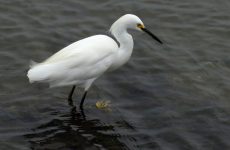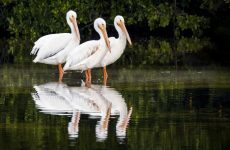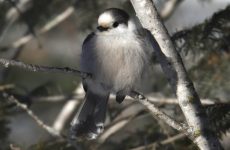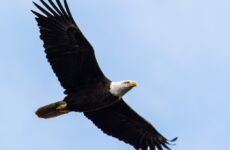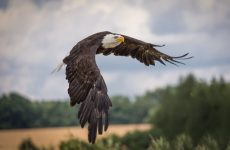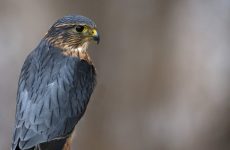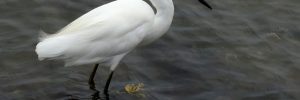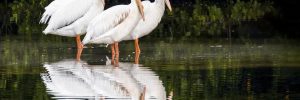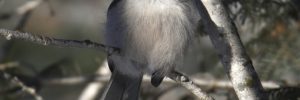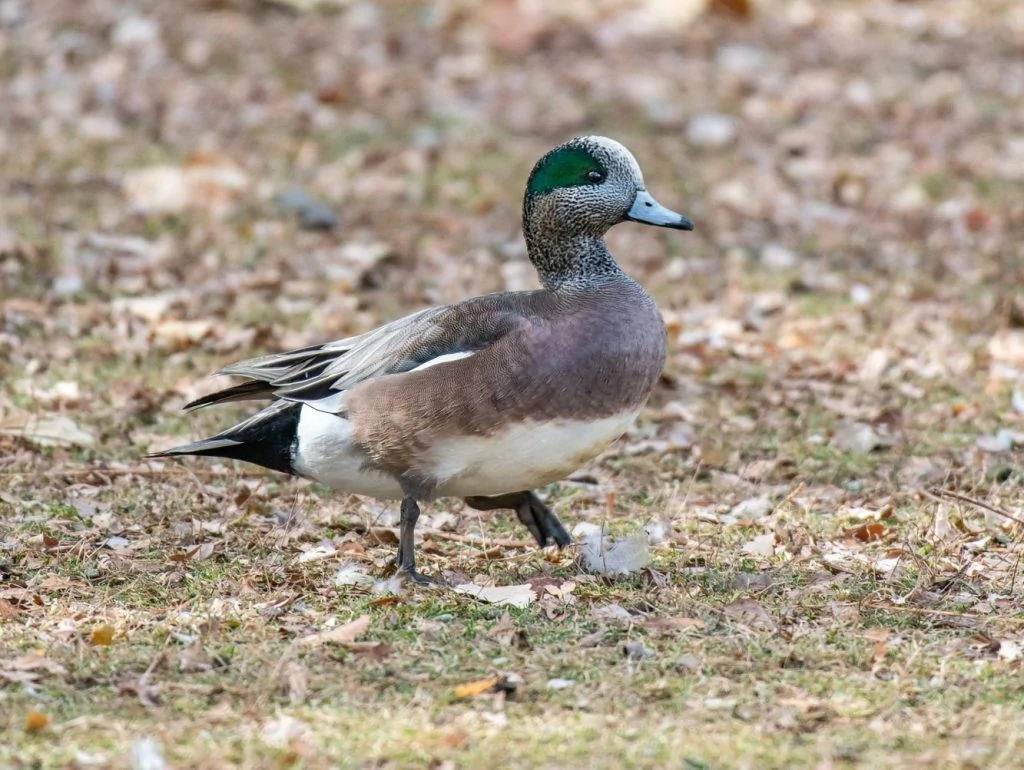
Most people know a few duck species but I bet you’re surprised by the number of duck species that can be spotted in Iowa.
This guide will help you identify all the species of ducks that can be spotted in Iowa with photo IDs and descriptions, audio recordings of their calls, fun facts, and more. Also, get a guide to help you identify ducks using clues such as ‘where is the white’ at the end of this article.
Ducks belong to many subfamilies, which also include swans and geese, but there is some debate and changing family groups for some species.
Ducks are omnivores and eat both plants and animals, especially insects, crustaceans, and small fish. They will eat plants both in the water and on land.
Ducks have hard pointed structures called lamellae around the edge of their beaks that look with teeth which they use to grasp vegetation and filter food through the water.
Male ducks are called drakes, and they are more colorful than females. Female ducks are either called ducks or hens. All domesticated ducks are descended from the mallard.
This guide will help you identify the types of ducks spotted in Iowa that are classed as regularly occurring according to avibase and the American Birding Association and uses data collected from bird watchers on ebird to give real information about when these birds can be spotted.
Ducks In Iowa By Season
Ducks in Iowa all year: Mallard, Ruddy Duck, Hooded Merganser
Ducks in Iowa in summer: Wood Duck, Blue-winged Teal
Ducks in Iowa in winter: Northern Pintail, American Black Duck, Lesser Scaup, Ring-necked Duck, Bufflehead, Redhead, Canvasback, Greater Scaup, Common Goldeneye, Common Merganser, Long-tailed Duck, White-winged Scoter
Ducks in Iowa during migration: Northern Shoveler, Gadwall, Green-winged Teal, American Wigeon, Cinnamon Teal, Red-breasted Merganser, Surf Scoter, Black Scoter
Types Of Ducks In Iowa:
There are 10 types of dabbling ducks, 7 types of diving ducks, and 8 types of sea ducks that have been spotted in Iowa.
Dabbling Ducks (10 Species)
Dabbling ducks are freshwater ducks that feed on the surface of the water or by tipping up with their heads into the water and their rears into the air.
They sweep their heads from side to side while taking small ‘bites’ or ‘nibbles’ of the water to filter out plants. They also feed on land for seeds and grain or insects.
There is still some debate about whether some of these ducks should be included in a different subfamily, and these include Wood Ducks, Mandarin Ducks, and Muscovy Ducks.
1. Mallard
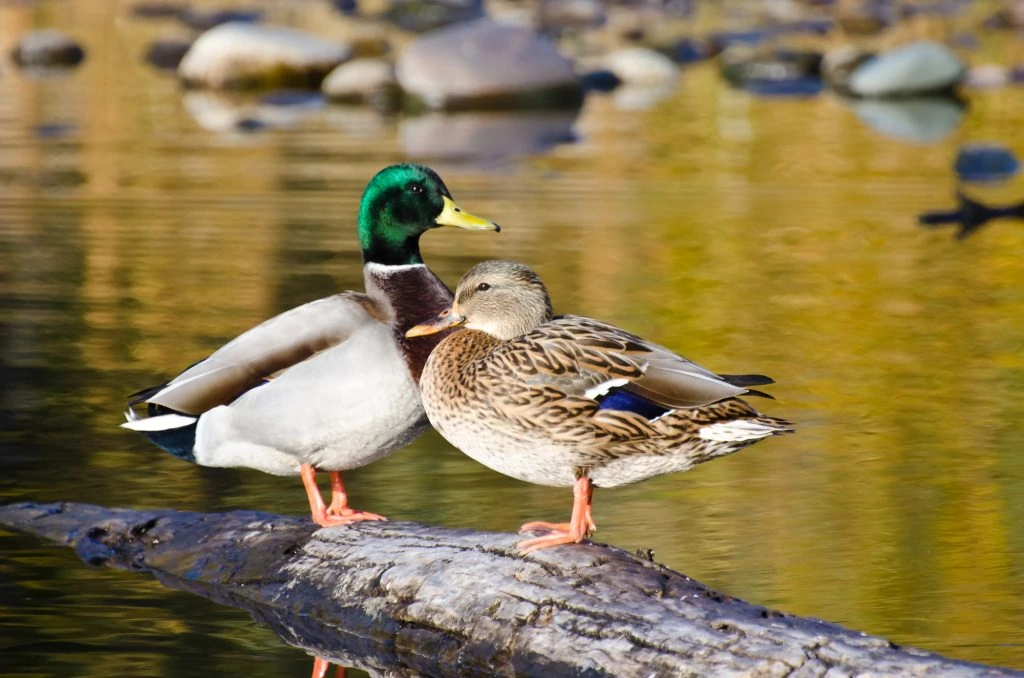
Mallards are spotted in Iowa all year. They are recorded in 20% of summer and 18% of winter checklists submitted by bird watchers for the state.
Mallards are large ducks, and the males have striking green heads. They also have bright yellow bills and gray bodies with brown breasts and black towards the tail. They have a curl of tail feathers and a blue patch on the wings bordered with white which is called a speculum.
Females and juveniles are mottled brown with orange bills but still have the blue speculum.
- Anas platyrhynchos
- Length: 19.7 – 25.6 in (50 – 65 cm)
- Weight: 35.3 – 45.9 oz (1000 – 1300 g)
- Wingspan: 32.3 – 37.4 in (82 – 95 cm)
Mallards remain all year in most of the lower 48 and the western coast of Canada and Alaska. Those that breed in Canada and Alaska head south to the southern United States and northern Mexico.
Mallards are one of the most commonly spotted and recognizable ducks that will happily be fed on ponds and rivers. They are dabbling ducks that feed on water plants and do not dive. They are very long-lived, and they have been recorded at 27 years old.
Mallard Calls:
Male Mallards don’t quack, only females do. Instead, the male makes a rasping sound.
Male Mallard Call
Female Mallard Call
Nests of Mallards are on the ground on land but close to the water. They are usually hidden under overhanging grass and made in a depression on the ground, filled with vegetation pulled from the surrounding area.
They lay up to thirteen eggs which take about 3 to 4 weeks to hatch, and the ducklings are ready to leave the nest almost immediately.
Fun Fact: Most domesticated ducks are descended from Mallards, and they have been hunted and bred for food.
2. Wood Duck
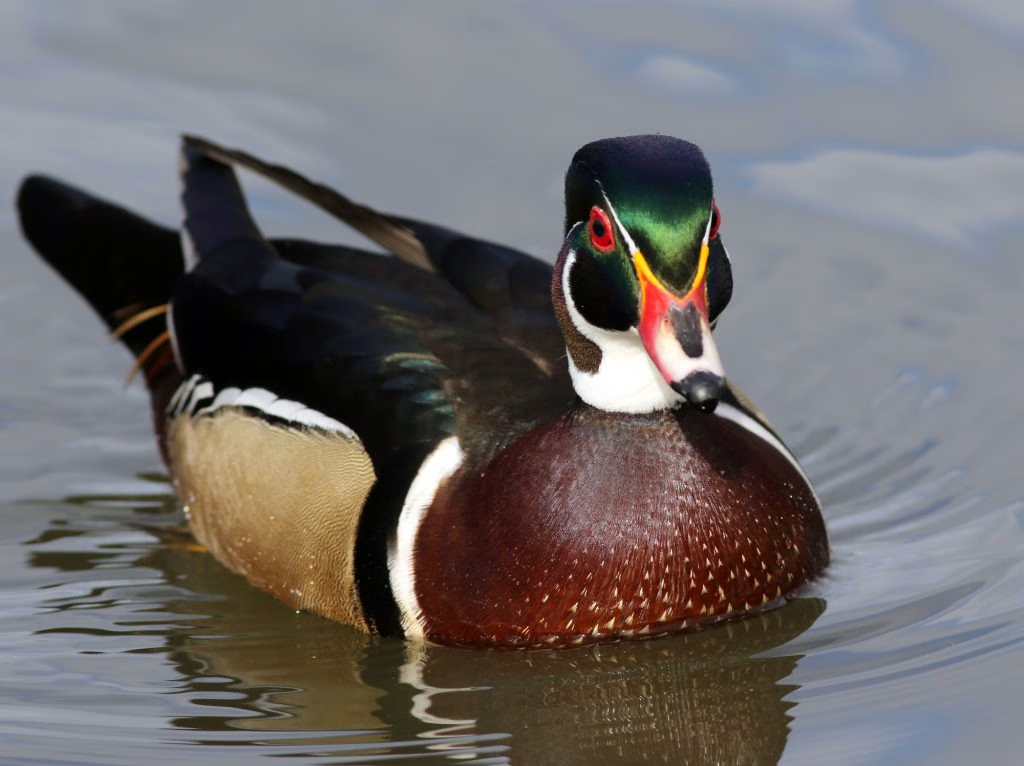
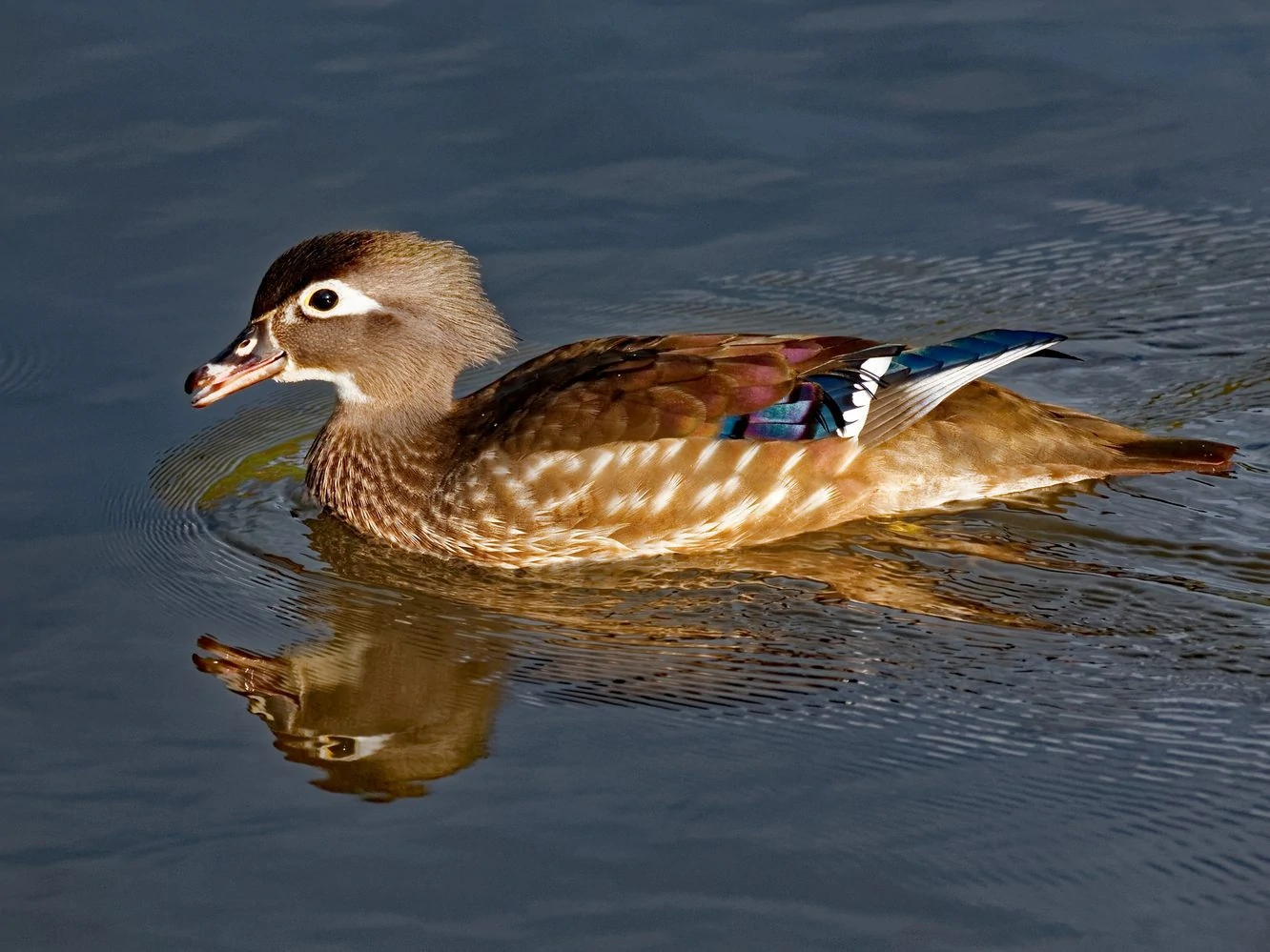
Wood Ducks spend their breeding season in Iowa and occur in 14% of summer checklists. There have been sightings all year, but they are usually spotted from March to September.
Male Wood Ducks have beautiful green heads with a striking crest at the back and black and white markings, and red eyes. They really are birds with great hairdos.
Their bodies are a checkerboard of colors, with reddish-brown chests, buff sides, brown backs and tails, white markings, and flashes of blue.
Females are brown with grayish-brown heads and white around their dark eyes. They have blue patches called speculum on their wings.
- Aix sponsa
- Length: 18.5 – 21.3 in (47 – 54 cm)
- Weight: 16.0 – 30.4 oz (454 – 862 g)
- Wingspan: 26.0 – 28.7 in (66 – 73 cm)
Wood Ducks are residents of eastern US states and along the Pacific Coast and parts of the northwest. Wood Ducks that breed in the north along the border with Canada migrate for winter to southern US states and Mexico.
You can find Wood Ducks in wooded swamps, and they eat seeds, fruit, and insects, usually in the water, but they will also feed on land in fields and forests.
Wood Ducks Calls:
Male Wood Ducks make a rising whistle, and female Wood ducks make a distinctive 2-note call.
Male Wood Duck call
Female Wood Duck call
Nests of Wood Ducks are usually in tree cavities, very near to water, and may be up to 60 feet off the ground. Females line the nest with down feathers plucked from their breasts. They lay up to sixteen eggs, which take 4 or 5 weeks to hatch, and the young use their clawed feet to climb out before jumping out.
Fun Fact: Female Wood Ducks often lay their eggs in other Wood Duck nests to be raised by others.
3. Blue-winged Teal
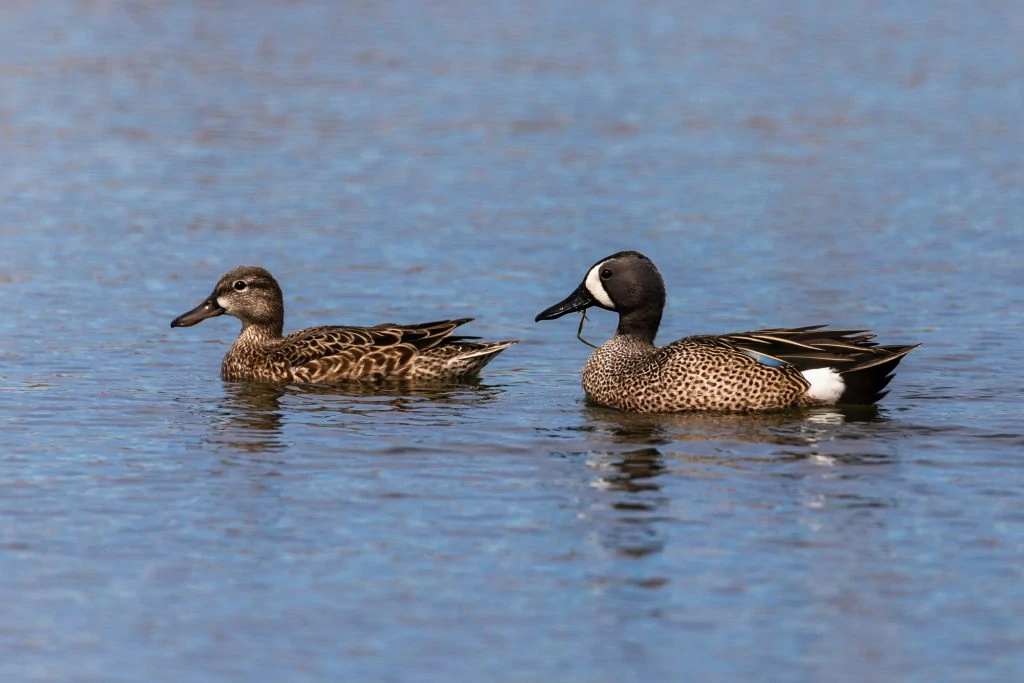
Blue-winged Teals are usually spotted in Iowa from mid-February to May, and some even stay until December. They appear in 10% of summer and up to 37% of checklists during spring migration.
Blue-winged teals are small ducks from the Anatidae family. Their head is bluish-gray with a white crescent in front of their eyes. Their body is spotted brown from the chest to the tail.
When their wings are unfurled, there is a distinct blue patch on the shoulders bordered with green and white. Females have the same scaly, brown pattern on their bodies, but they have no distinctive white markings on their faces.
- Spatula discors
- Length: 15 – 17 in (38 – 43 cm)
- Weight: 19.18 oz (544 g)
- Wingspan: 23 -31 in (58 – 79 cm)
Blue-winged Teals breed in the US and Canada before migrating to Florida, the Gulf Coast, southern West Coast, Mexico, Central and northern South America, and the Caribbean.
You can find Blue-winged Teals on shorelines with calm or sluggish water, so lakes and ponds with protruding trees and rocks are perfect. They also live around shallow water sources with abundant vegetation, like marshes and swamps. During the breeding season, you’ll find them in northern prairies and parklands.
Blue-winged Teals mostly eat aquatic plants that they find on the surface of their water. They may also eat aquatic insects, particularly during the breeding season.
Blue-winged Calls: They make high-pitched chattering calls, and females also quack.
Blue-winged Teals chattering calls
Female Blue-winged Teal Quack
Nests of Blue-winged Teals are often found in a hollow in the ground, sheltered behind tall grasses and near a water source. They are built from grass and weeds and lined with down.
Females lay up to fifteen eggs that they incubate for 2 to 3 weeks. The young ducklings may be able to walk a few hours after hatching, but they can only fly after six to seven weeks.
Fun Fact: Because of their long, over-ocean migration patterns, Blue-winged Teals have the highest mortality rate among dabbling ducks.
4. Northern Shoveler
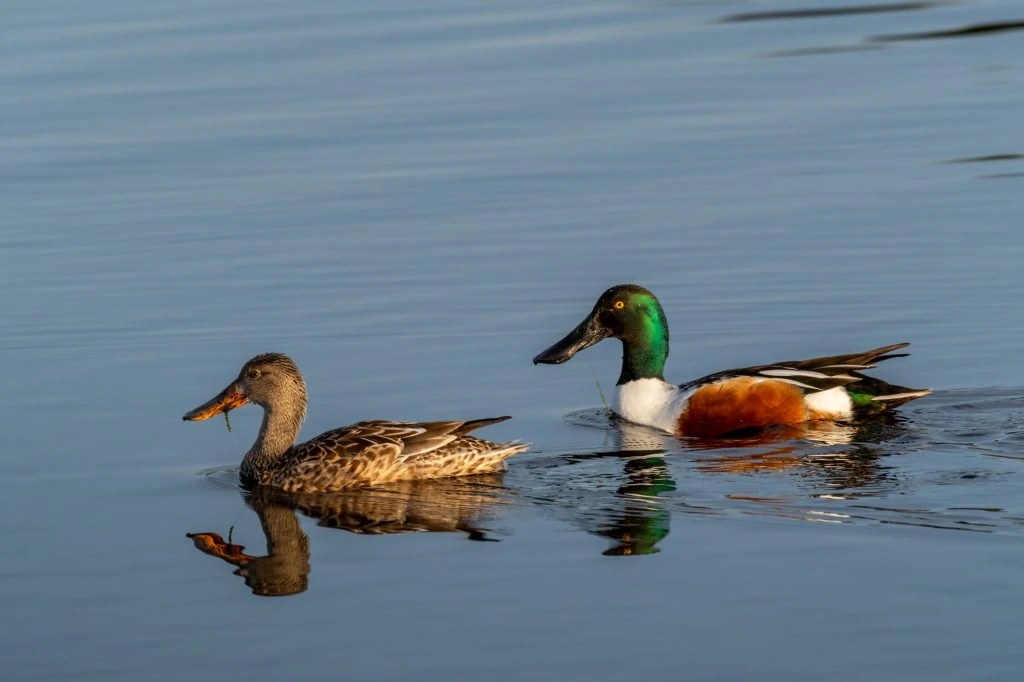
Although some can be seen all year, Northern Shovelers are frequently spotted in Iowa during migration. They appear in up to 28% of spring and 10% of fall checklists.
Northern Shovelers are dabbling ducks, and males have green heads and large spoon-shaped black beaks that make them easy to spot. They have reddish-brown sides, white chests, and black backs. Males also have blue patches on the wings.
Females are mottled brown with a blue shoulder patch and large orange beaks.
- Spatula clypeata
- Length: 17.3 – 20.1 in (44 – 51 cm)
- Weight: 14.1 – 28.9 oz (400 – 820 g)
- Wingspan: 27.2 – 33.1 in (69 – 84 cm)
Northern Shovelers spend the winter in the southern half of the US and along the Pacific and Atlantic Coasts up to Canada. They migrate to the western half of Canada and northwestern US states for breeding in the summer. Some also breed around the Great Lakes.
You can find Northern Shovelers in sociable groups in shallow, stagnant water.
Crustaceans, invertebrates, and some seeds make up the diet of shovelers, and they filter them out by stirring up the bottom and swinging their bills from side to side through the water. They then push the water out through comblike projections called lamellae along the edge of their bills, catching any food.
Northern Shoveler Calls: Male Northern Shoveler calls sound like ‘hook-hook’ or ‘took-took’. Females have a nasal quack.
Male Northern Shoveler call
Female Northern Shoveler call
Northern Shovelers nest on the ground in short vegetation close to water. They lay around ten eggs, which take 3 to 4 weeks to hatch. The ducklings can walk and swim immediately.
Fun Fact: Northern Shovelers will sometimes form large groups that swim in circles to help stir up the bottom for feeding.
5. Gadwall
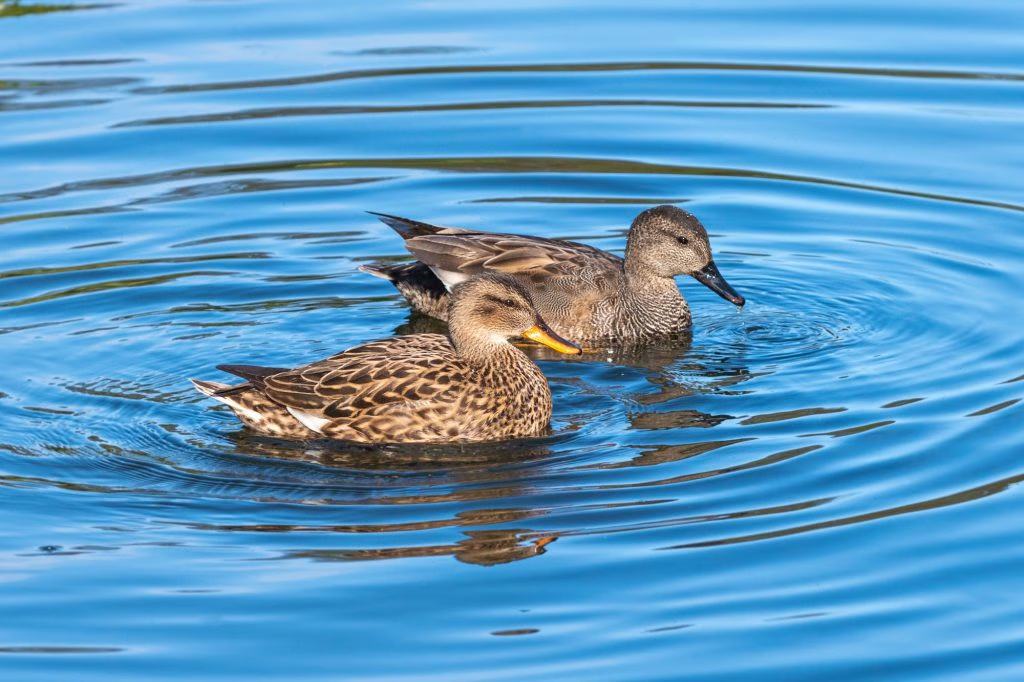
Gadwalls are spotted in Iowa all year, but their numbers increase during migration, from March to April and from October to November. They occur in up to 17% of spring and 11% of fall checklists.
Gadwalls are large dabbling ducks that stand out despite their understated coloring. Compared to other bright and colorful dabbling ducks, Gadwalls are subtly colored with dark-brown heads, black, scaled patterns on the chest and shoulder, gray or white on their bellies, and black bottoms.
When in flight, a small, white patch can be seen on their wings. Females are generally brown all-over, with a more diffused scale pattern on their shoulder, back, chest and bottom.
- Mareca strepera
- Length: 19 – 23 in (48 – 58 cm)
- Weight: 35.27 oz (1000 g)
- Wingspan: 31 – 36 in (79 – 91 cm)
Gadwalls breed in the plains of the United States and Canada before migrating to central and southern US states and Mexico. Some remain all year on the West Coast.
You can find Gadwalls in open wetlands, grasslands, and marshes with dense vegetation. In winter, you can see Gadwalls in saltwater marshes, city parks, reservoirs, and muddy estuaries.
Gadwalls feed themselves by dabbling in shallow water. They submerge their heads until they can reach for plants and other vegetation underwater. They may occasionally feed on insects, too.
Gadwall Calls: Male Gadwalls make short reedy whistles, followed by a quack. Females quack and sound similar to mallards.
Male Gadwall call
Female Gadwall call
Nests of Gadwalls are often hard to find because they’re hidden in dense vegetation near water. They are made with grass and weeds and lined with feathers. There may be as many as fifteen eggs in a nest. The female incubates them for about twenty-seven days until they’re hatched.
Fun Fact: Gadwalls sometimes steal food from other dabbling ducks as they surface from diving.
6. Green-winged Teal
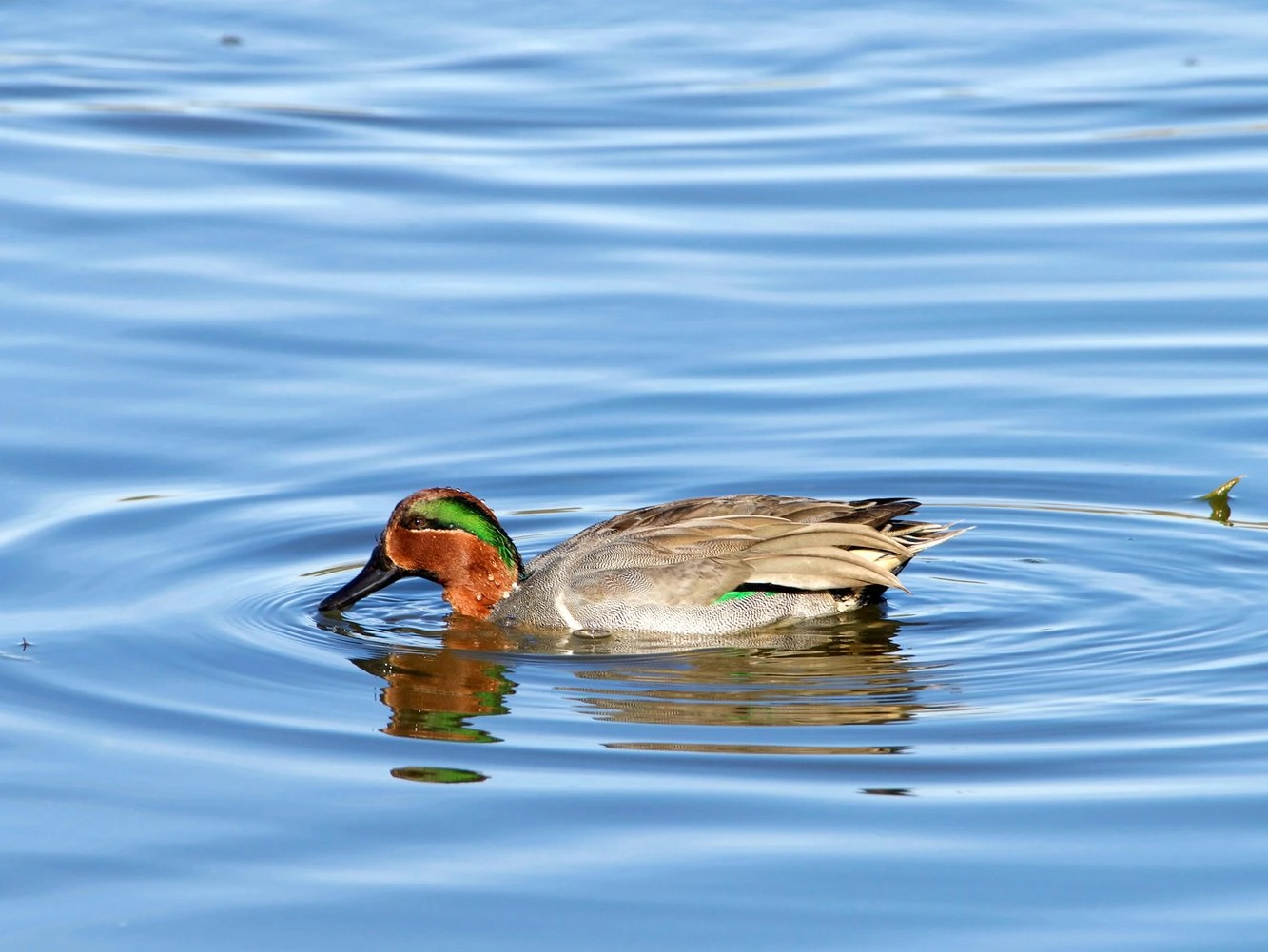
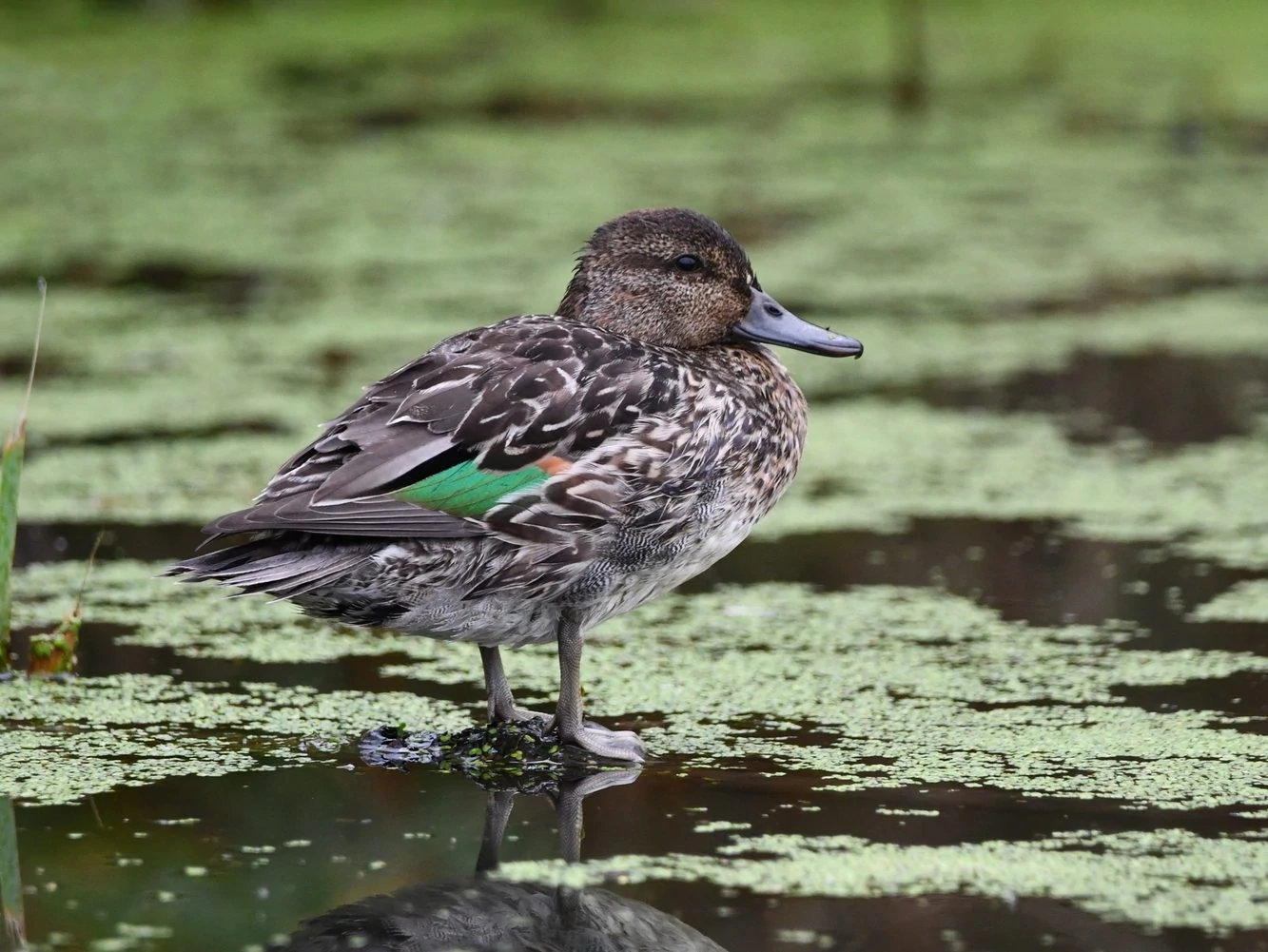
Green-winged Teals are spotted in Iowa all year, but they are mainly seen during migration, from March to April and from October to November. They occur in up to 15% of spring and 8% of fall checklists.
Green-winged Teals are small dabbling ducks. Males have a green stripe along the sides of their heads. The rest of their heads are brown, and they have grayish bodies.
Females are brown with a yellow streak along the tail. Both males and females have a green wing patch.
- Anas crecca
- Length: 12.2- 15.3 in (31 – 39 cm)
- Weight: 4.9 – 17.6 oz (140 – 500 g)
- Wingspan: 20.5 – 23.2 in (52 – 59 cm)
Most Green-winged Teals migrate from breeding grounds in Alaska, Canada, and northern US states to the southern US states and the Pacific Coast. However, some ducks remain around the Rocky Mountains all year.
You can find Green-winged Teals on flooded ground and shallow ponds in large flocks of up to 50 thousand. They feed on invertebrates and seeds.
Nests of Green-winged Teals are on the ground in dense cover such as grass or thickets.
Green-winged Teal Calls: Male Green-winged Teals whistle and chatter, and females have a high-pitched quack.
Male Green-winged Teal
Female Green-winged Teal
Nests of Green-winged Teals are on the ground in meadows and grasslands and near water. They lay up to nine eggs, which take around 3 weeks to hatch. The ducklings are ready to leave the nest almost immediately.
Fun Fact: Green-winged Teals don’t need to run across the surface of the water to take off. They can fly straight away as they are so agile.
7. Northern Pintail
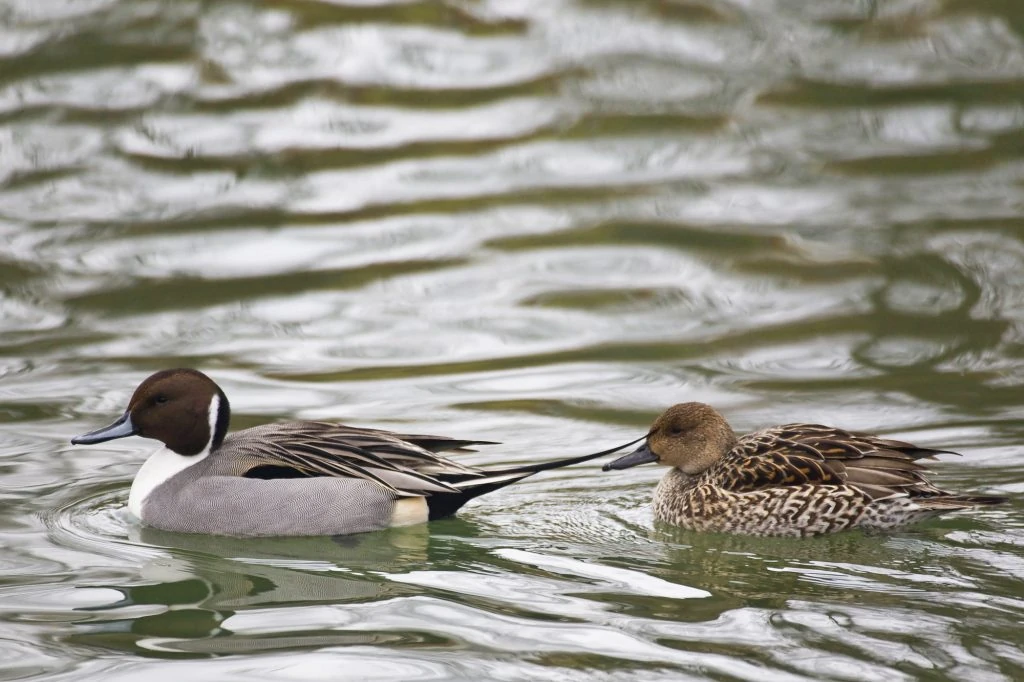
Northern Pintails are spotted in Iowa during winter and are recorded in 1% of checklists at this time. However, they are most common in March and appear in 11% of checklists during spring migration.
Northern Pintails are ducks known for their long pointy tails. Males have a beautiful brown head, with a contrasting white vertical stripe down their neck. Their bodies are white, and they have gray, white, and black patterns on their back. When in flight, their wings display a green patch.
Females are brown with intricate scaled patterns on their bodies. They also have a brown patch on their wings.
- Anas acuta
- Length: 20 – 26 in (51 – 66 cm)
- Weight: 36.33 oz (1030 g)
- Wingspan: 29 – 35 in (74 – 89 cm)
Northern Pintails breed in Canada, Alaska, and the Midwest before migrating to southern and coastal US states.
You can find Northern Pintails living with other duck species in open wetlands, marshes, prairies, and even in agricultural fields. They forage on the edges of lakes and ponds but are known to dabble in open water with other ducks. During winter, they will migrate to coastal lagoons, sheltered estuaries, and brackish marshes.
Northern Pintails have a distinct advantage over ducks when dabbling for food. With their long necks, they can reach 12 inches deep into the water, much further than other ducks. They feed on seeds and roots of aquatic vegetation. They also eat seeds and grain from agricultural fields. During the breeding season, they eat more animals for protein, like aquatic insects and mollusks such as snails.
Northern Pintail calls:
Male Northern Pintail
Female Northern Pintail
Nests of Northern Pintails are usually found in shallow hollows on the ground, close to a water source. They are made with grasses and feathers and serve as home to at least twelve eggs.
The female incubates them for as many as twenty-five days and will lead the young to the water as soon as they’re hatched so they can feed on insects by themselves. They can fly in about fifty days but will not leave the nest until the female has completed molting.
Fun Fact: Because Northern Pintails are agile and speedy birds, they are often hunted as a challenge in game shooting.
8. American Wigeon
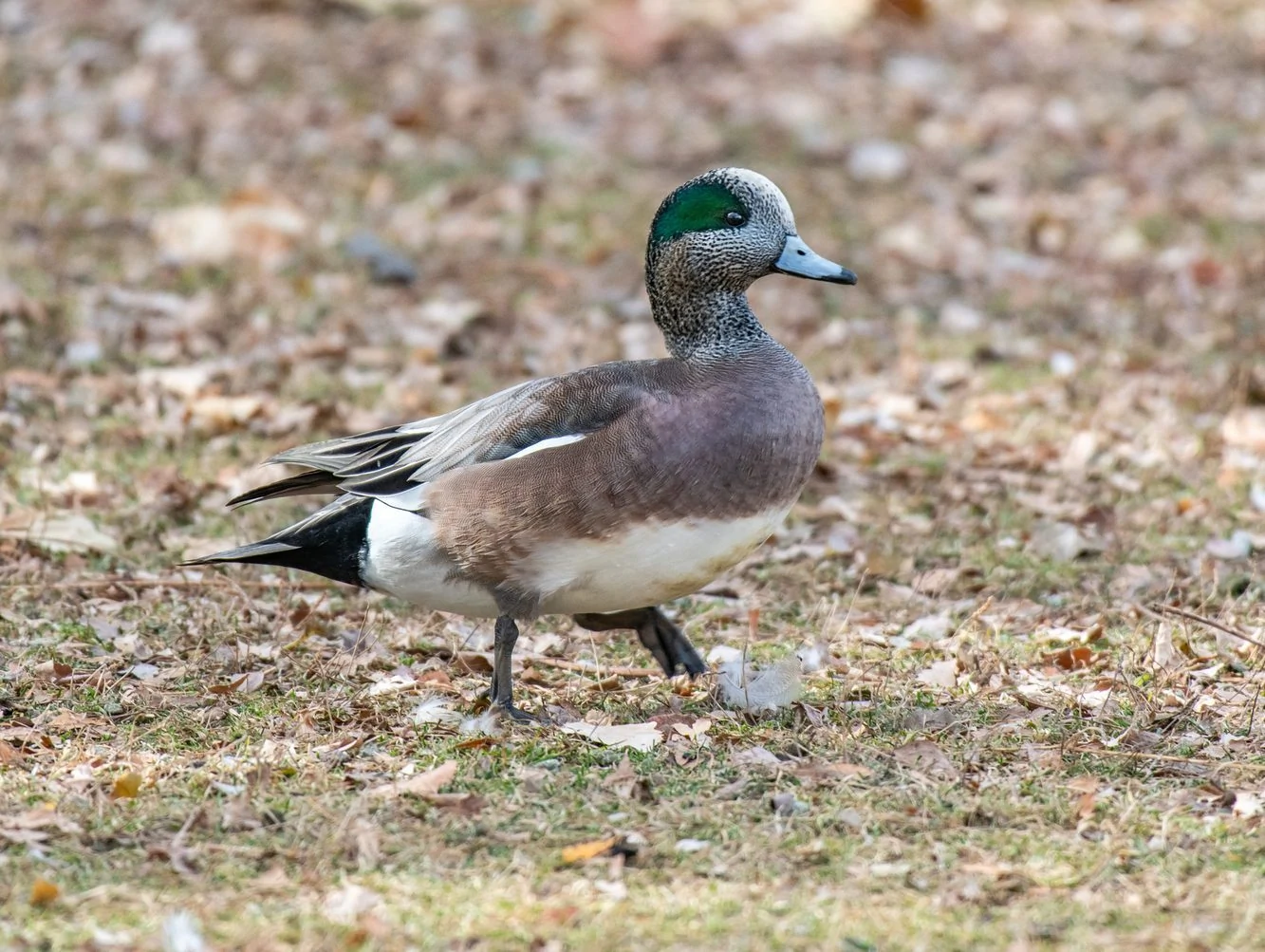
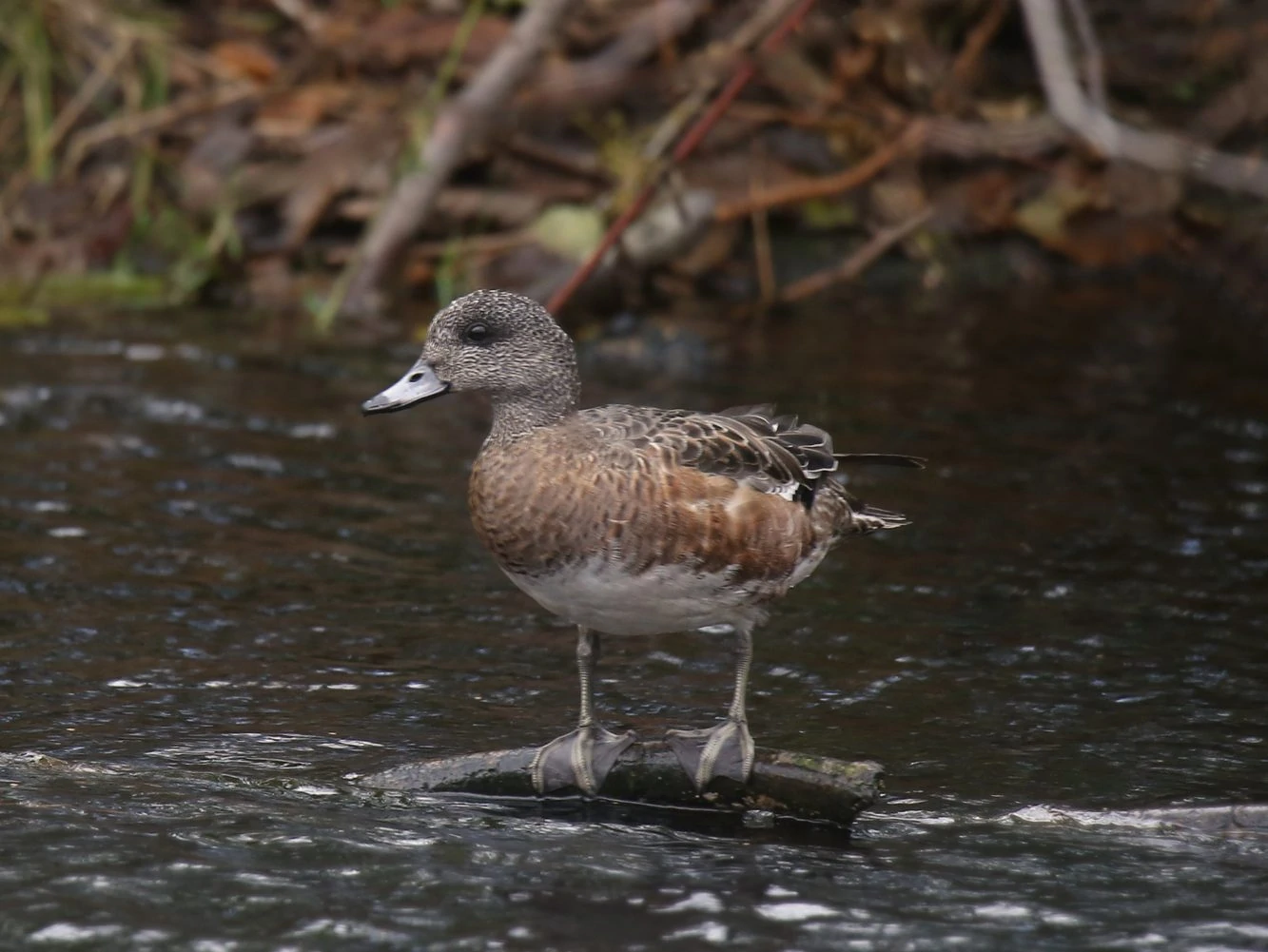
American Wigeons are usually seen migrating across Iowa, but some can be spotted all year. They appear in up to 10% of spring and 4% of fall checklists.
American Wigeons are small ducks with green stripes on the sides of their heads and with white caps on the males. The rest of them are grayish-brown.
Females are brown with grayish-brown heads. Male and females both have pale beaks.
- Mareca americana
- Length: 16.5 – 23.2 in (42 – 59 cm)
- Weight: 19.1 – 46.9 oz (540 – 1330 g)
- Wingspan: 33.1 in (84 cm)
American Wigeons breed predominantly in Alaska, western Canada, and northwestern US states. They spend the winter in the southern and central US states and along the Pacific and Atlantic coasts.
You can find American Wigeons feeding on vegetation both in the water and on the land in wetlands, fields, and ponds. They will also eat insects and invertebrates.
American Wigeon Calls: Male American Wigeons give a high-pitched whistle, and females make a harsh grunt.
Male American Wigeon call
Female American Wigeon call
Nests of American Wigeons are on the ground, far from water in fields and grasslands. The female lines the depression in the ground with grass, reeds, and down feathers, then they lay up to 13 eggs which take 2 to 3 weeks to hatch. The ducklings leave the nest almost immediately.
Fun Fact: American Wigeons are known as ‘baldpate’ because their white stripe looks like a bald man’s head.
9. American Black Duck
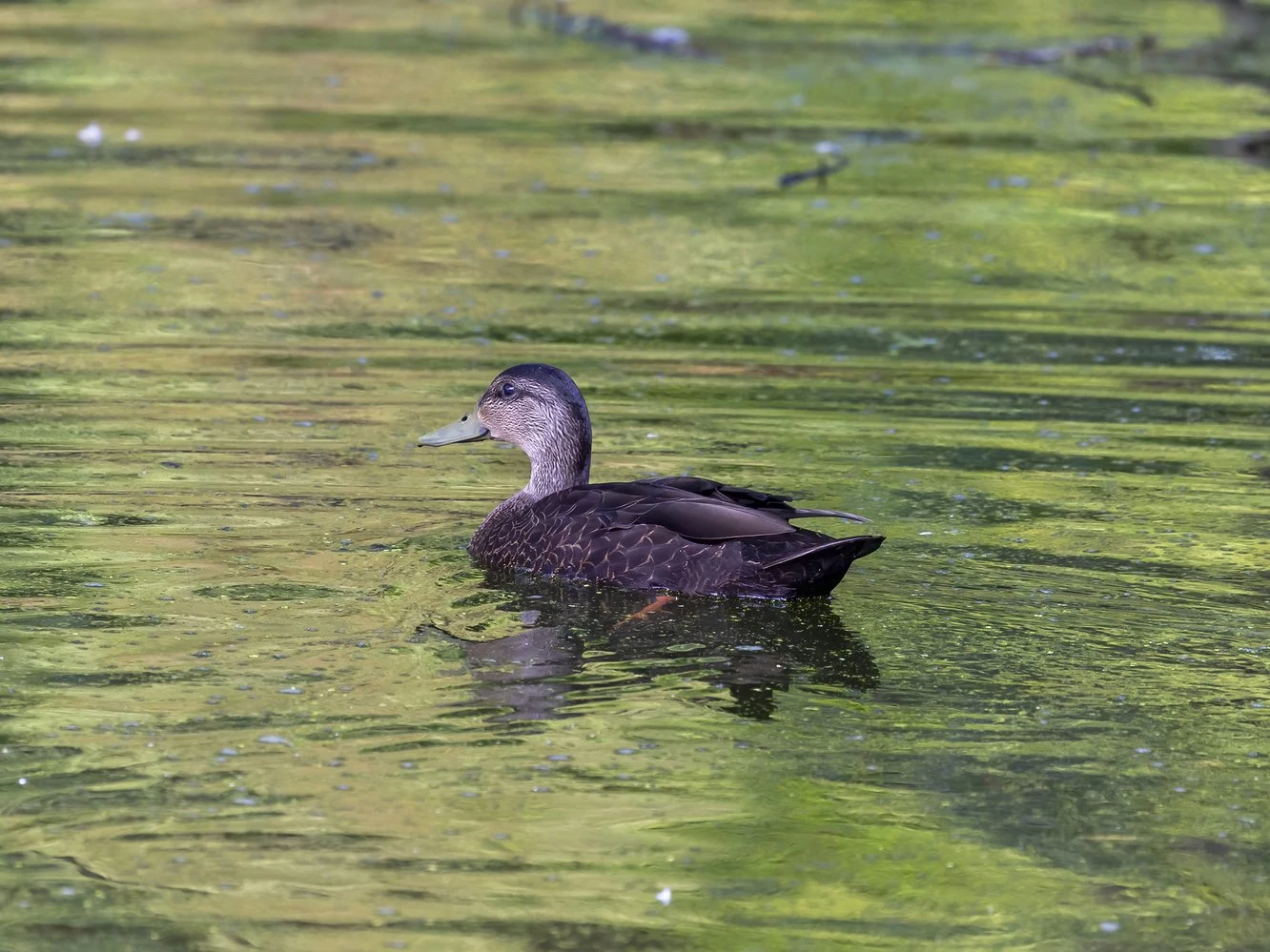
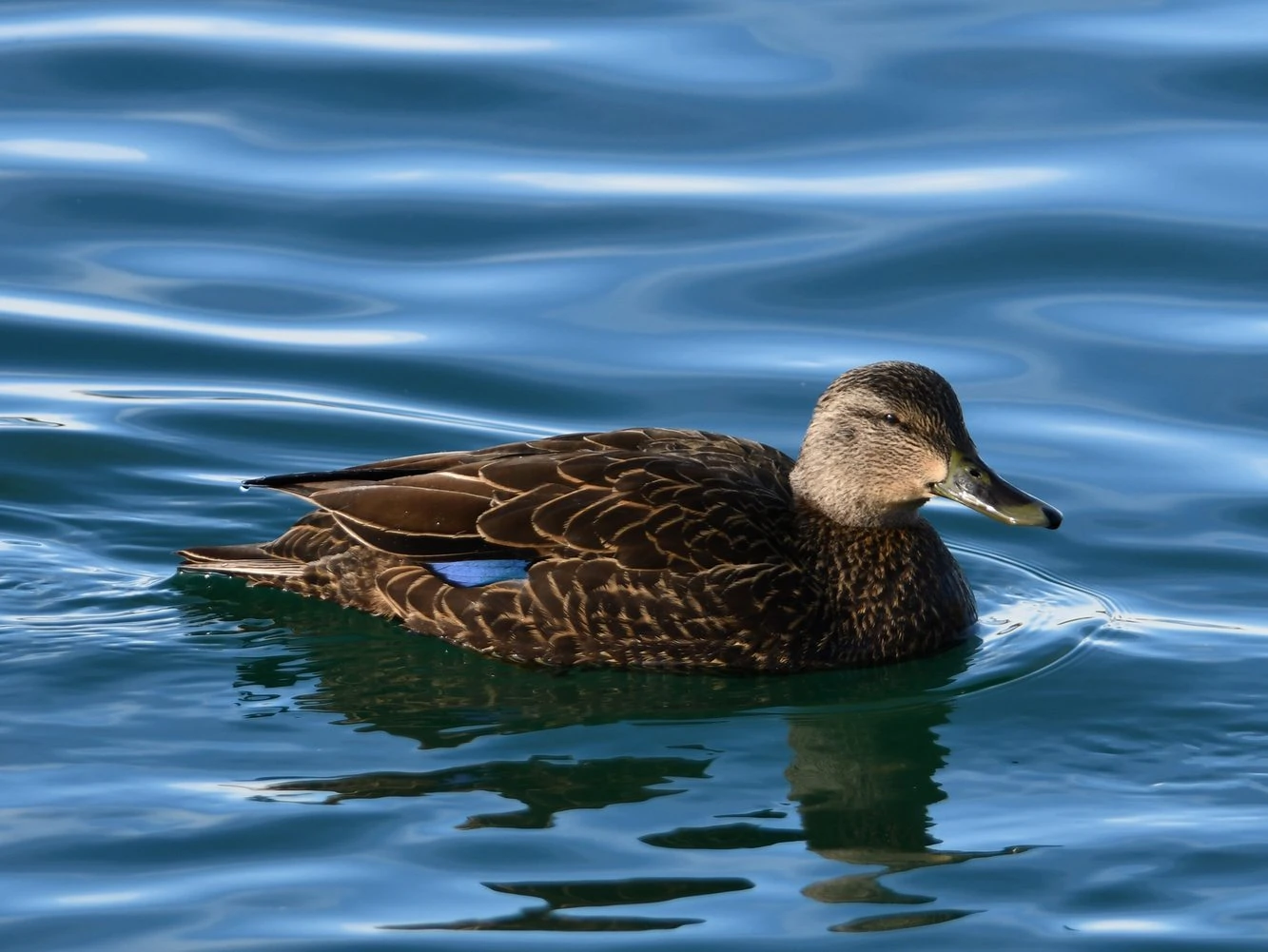
American Black Ducks are winter birds in Iowa and are mainly spotted from October to May. They appear in around 1% of winter checklists.
American Black Ducks are large, heavy ducks from the Anas family. They’re quite possibly the heaviest ducks in the species. Males and females have the same dark brown bodies and pale brown heads. Males have a yellow bill, and females have an olive one. The only bright colors on their bodies are the blue-purple patch on their wings and their red-orange legs.
- Anas rubripes
- Length: 19 – 23 in (48 – 58 cm)
- Weight: 49.6 oz (1406 g)
- Wingspan: 33 – 36 in (84 – 91 cm)
American Black Ducks are found in eastern regions. They breed in eastern Canada and spend the winter in eastern US states. Some remain all year in northeastern US states.
You can find American Black Ducks in many different habitats. Ordinarily, they inhabit salt marshes, lakes, ponds, and estuaries. They are also seen in forested swamps, beaver ponds, agricultural fields, and flooded woods. Also, they may reside in tidal marshes, and when they want to hide from hunters, they stay on conservation land.
American Black Ducks can look for food on both land and water. Aside from dabbling, they also graze on land. They eat aquatic vegetation, animals like snails, insects, mussels, small fish, and grasses and seeds from fields.
American Black Duck calls: Male American Black ducks have a more reedy call than the females’ loud quack.
Male American Black Duck
Female American Black Duck
Nests of American Black Ducks usually have six to fourteen eggs that both parents care for. However, the male will leave the responsibility to the female when they reach the 2nd half of the incubation period.
Incubation usually takes twenty-six days, and the newly-hatched chicks are brought to the water to learn to forage for food. It takes another six weeks for the young to learn how to fly.
Fun Fact: 11,000-year-old fossils of American Black Ducks have been discovered in Florida and Georgia.
10. Cinnamon Teal
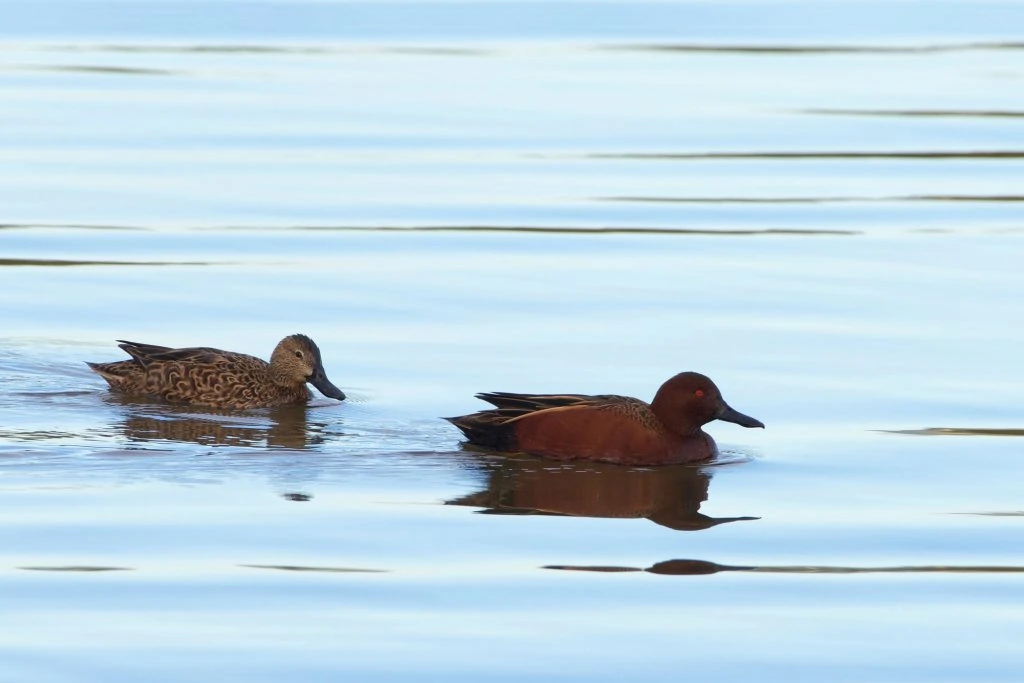
Cinnamon Teals are not often spotted in Iowa, but you might see some during spring migration from mid-March to May.
Cinnamon Teal breeding males are the reason why these birds are named as such. They’re cinnamon-colored all over during the breeding season, and even their eyes are red. On their backs, they have a scaly reddish-brown patch. They have a pale blue shoulder and a white line that separates it from the greenish lower wing.
Males will molt this glossy coloring and will then look similar to the females in winter. Females are brown with a scaly pattern on their chest, belly, and back.
- Spatula cyanoptera
- Length: 14- 17 in (36 – 43 cm)
- Weight: 16.4 oz (465 g)
- Wingspan: 24 – 30 in (61 -76 cm)
Cinnamon Teals breed in western US states and southwestern Canada before migrating for winter to Mexico and South America. Some ducks remain all year in southwestern US states, Mexico, and South America.
You can find Cinnamon Teals in freshwater marshes and ponds. Cinnamon Teals belong to the Dabbling Duck family, so they live on food that they can find by skimming the surface of the water, especially in shallow water. They eat seeds, plants, and aquatic insects. They may opt to dabble just below the surface for submerged plants in deeper waters.
Cinnamon Teal calls:
Male Cinnamon Teal
Female Cinnamon Teal
Nests of Cinnamon Teals are built on the ground, usually sheltered among tall grasses and vegetation but still near the water. The nests are made with grass made even softer with down. There can be up to twelve eggs in a nest, and it takes up to twenty-five days for the eggs to hatch. After about 50 days, the young can fly on their own.
Fun Fact: Cinnamon Teals change breeding partners every year.
Diving Ducks (7 Species)
Diving ducks are so called as they dive to the bottom of deeper water in search of food in freshwater, tidal lagoons, and estuaries. They are members of the Aythyini subfamily and are different from the sea diving ducks that are members of the Merginae subfamily.
Diving ducks’ legs are placed further back to help them swim and dive and so they do not usually walk on land as dabbling ducks do. They eat fish, aquatic plants, and shellfish.
11. Lesser Scaup
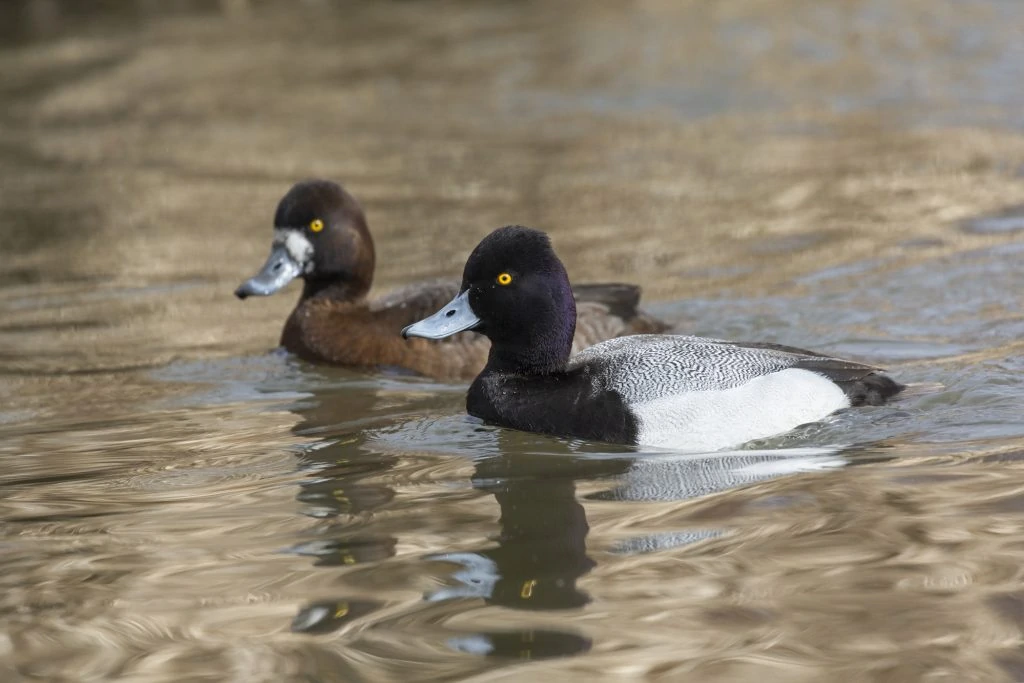
Lesser Scaups are usually spotted in Iowa during winter and occur in 3% of checklists at this time. However, their numbers increase from March to April and are recorded in up to 22% of checklists during spring migration.
Lesser Scaups are medium-sized diving birds that are pretty similar and often mistaken for Greater Scaups. What makes them different is that Lesser Scaups have a small group of hairs at the tip of their heads. It makes their head look steeper than Greater Scaups.
Their heads, chests, and bottoms are all black with a purple sheen. Their eyes are golden yellow. Their sides are white, and their backs are grayish with an intricate pattern.
Females have dark-brown heads, a white patch on their face next to their bills, gray sides, and are brown all over, and no extra tuft of hair on the head like the males.
- Aythya affinis
- Length: 15 – 18 in (38 – 49 cm)
- Weight: 40.77 oz (1155 g)
- Wingspan: 24 – 33 in (61 – 84 cm)
Lesser Scaups breed in northwestern US states, western Canada, and Alaska before migrating to southern US states, Mexico, and the east and west US coasts. They can be seen during migration across the rest of the US and Canada.
You can find Lesser Scaups in large lakes, rivers, ponds, and reservoirs. They usually flock together by the thousands during winter, and they often look like floating vegetation when viewed from afar.
Lesser Scaups feed primarily on mollusks and clams that they find after diving into the water and sifting through the bottom. They also dabble in the water for plant vegetation like bulrushes, wild celery, wild rice, and pondweeds.
Recently, they have begun to feed on zebra mussels in Lake Erie, which may endanger their health because these animals are filter feeders and contain environmental contaminants.
Lesser Scaup calls: Male Lesser Scaups are quiet and only make soft gurgle calls. However, females are much louder and make harsh grunts.
Male Lesser Scaup
Female Lesser Scaup
Nests of Lesser Scaups are usually found on the ground very close to the water. Females may share their nests with others, so one nest may contain eggs from more than one female. The nests themselves are scraped and lined with plants and feathers.
One female may lay up to eleven eggs, but the nest may contain up to twenty-six eggs, including those from other females. Incubation lasts only three weeks, and the young immediately head to the water after hatching.
The young are cared for by the females, but they can feed themselves. In about fifty days, they can fly and migrate with the others.
Fun Fact: An adult Lesser Scaup may pretend to be dead when in the jaws of a predator like the Red Fox.
12. Ring-necked Duck
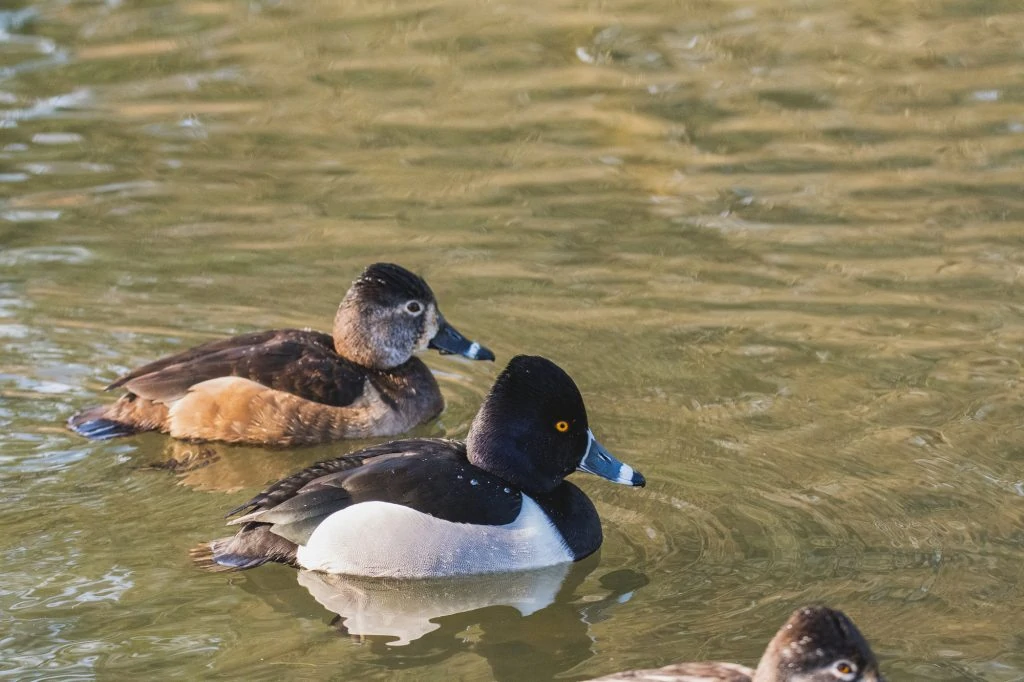
Ring-necked Ducks are spotted in Iowa during winter, but more during migration from March to April and in November. They appear in up to 22% of checklists during spring migration and 9% of checklists during fall.
Ring-necked Ducks are medium-sized ducks that have a steep black forehead, a gray bill fringed with white and a black tip, a black chest and back, and a white breast and belly. They have a cinnamon collar around their neck.
Females don’t show the ring and are mostly brown everywhere except for their gray faces and white outline around their eyes. Their bills also don’t have the white outline the males have, but they do have a white band near the black tip of their bill.
- Aythya collaris
- Length: 14 – 18 in (36 – 46 cm)
- Weight : 32.09 oz (909 g)
- Wingspan: 24 – 30 in (61 – 76 cm)
Ring-necked Ducks breed in Canada and northeastern US states before migrating to southern and western US states, Mexico, northern Central America, and the Caribbean.
You can find Ring-necked Ducks in small, shallow ponds and rivers. Breeding habitats may include wooded lakes in forests.
You can find Ring-necked Ducks foraging on the surface and only occasionally diving below the water in small, shallow ponds and rivers. Even though they are diving ducks, they behave more like dabbling ducks.
They eat plants on the surface of the water and submerged plants like pondweed. They also eat wild rice and animals such as earthworms, leeches, and snails.
Ring-necked Duck Calls: A series of barking grunts
Nests of Ring-necked Ducks are bowl-shaped and built on shallow water with a lot of vegetation for cover. They are made with plant materials and can hold as many as ten eggs. The females incubate these eggs for about a month and stay with the young until they’re ready to fly.
Fun Fact: Though you may think that the ring around the Ring-necked Duck is used to easily distinguish them from other birds, you’d be mistaken. It’s hardly noticeable. Better to look for their steep, black forehead and blue-gray bill with the white band.
13. Bufflehead
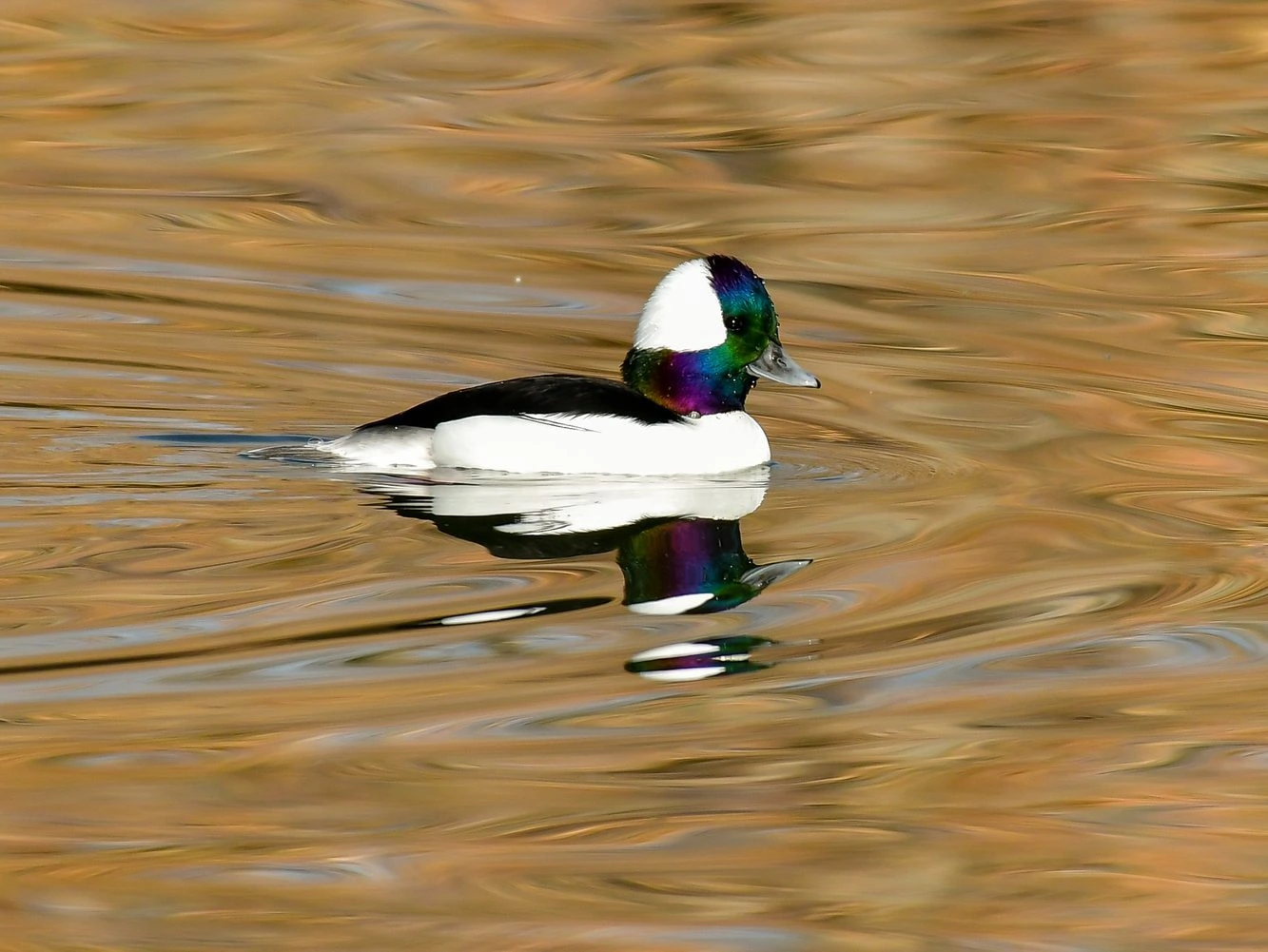
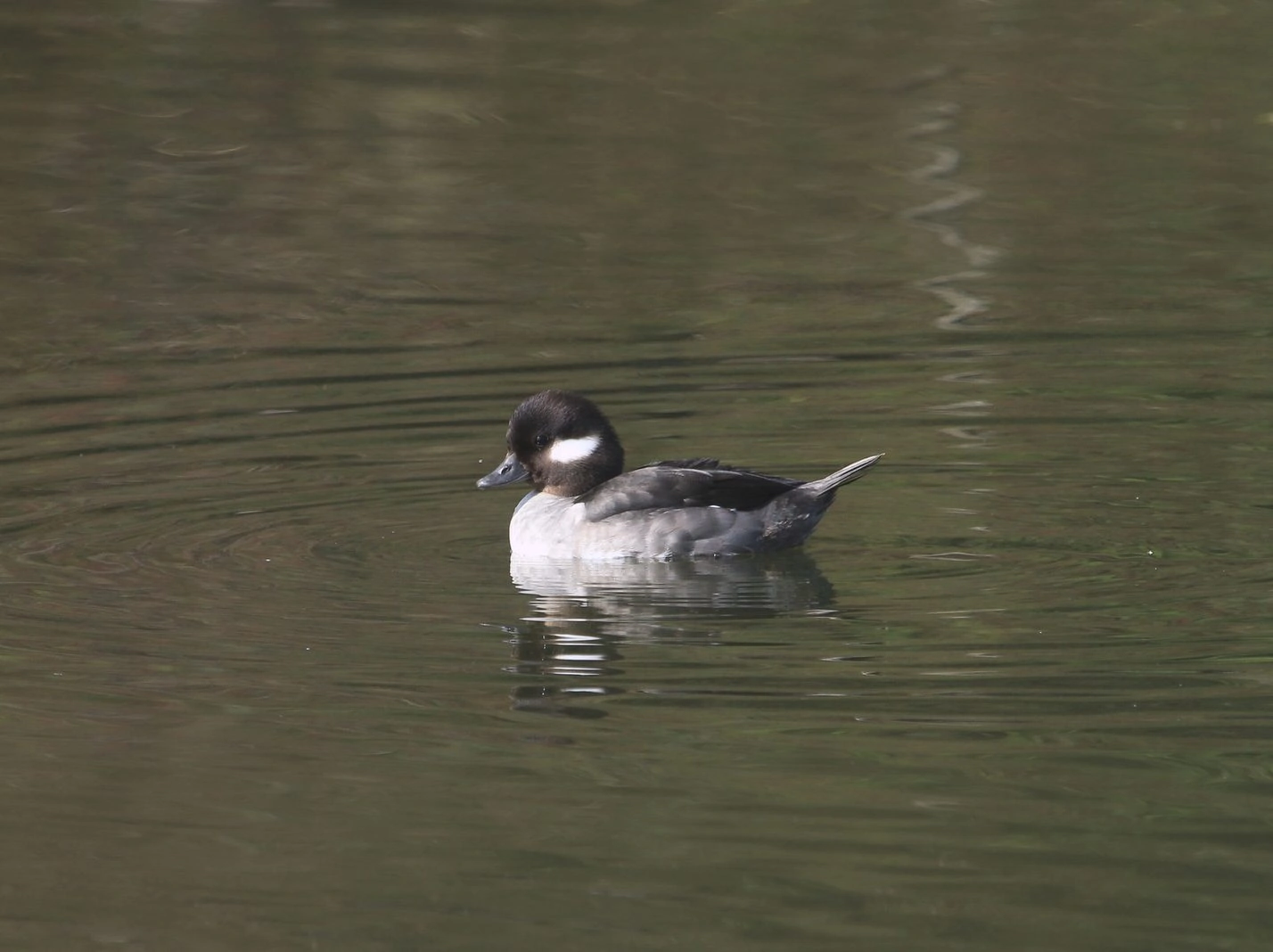
Buffleheads are winter birds in Iowa and are usually spotted from October to mid-June. However, their numbers increase during migration, from March to April and in November. They appear in up to 21% of spring and 12% of fall checklists.
Buffleheads are small birds with bulbous heads, hence their name, “bullheaded,” from ancient Greek. Male Buffleheads are easily recognizable because of the huge white patch behind their eyes. This patch highlights the glossy green and purple colors on the crown, forehead, throat, and neck. The bottom half of their bodies are white, while the upper half is black.
Female Buffleheads look nothing like the males, except for the bulbous head. They have dark brown or black heads with a white patch below the eye. Their bottom half is gray, and their top half is black. Juveniles look similar to females with their brown heads and a white patch on the head.
- Bucephala albeola
- Length: 13 – 16 in (33 – 41 cm)
- Weight: 21.16 oz (600 g)
- Wingspan: 20 – 24 in (51-61 cm)
Buffleheads breed mainly in Canada before migrating to the US, northern Mexico, and Canada’s Pacific coast. They can be seen during migration in the Midwest and the Appellations.
You can find Buffleheads in small lakes and ponds with nearby poplar and aspen forests during the breeding season. In the winter, they move to protected coastal waters or shallow bays and inlets.
Buffleheads mostly dive as they forage for food. They catch mollusks, crustaceans, and aquatic insects, which they eat while underwater.
Bufflehead Calls: Buffleheads are quiet birds and don’t make particularly loud calls. Males usually only make sounds around the breeding season and make chattering sounds or squeals. Females call to their young.
Male Bufflehead call
Female Bufflehead call
Nests of Buffleheads are often found in tree cavities, particularly those previously used by Northern Flicker woodpeckers. These are very small tree holes that are close to water. The female places several down feathers on the nest just enough to cover the eggs. She lays from six to eleven eggs that she incubates for thirty days.
Attract Buffleheads to your backyard by putting up nest boxes. There is a lot of nest competition with other goldeneyes, which drives Buffleheads to seek safer and better nesting areas.
Fun Fact: Buffleheads are monogamous ducks and may remain with their chosen mate for several years.
14. Ruddy Duck
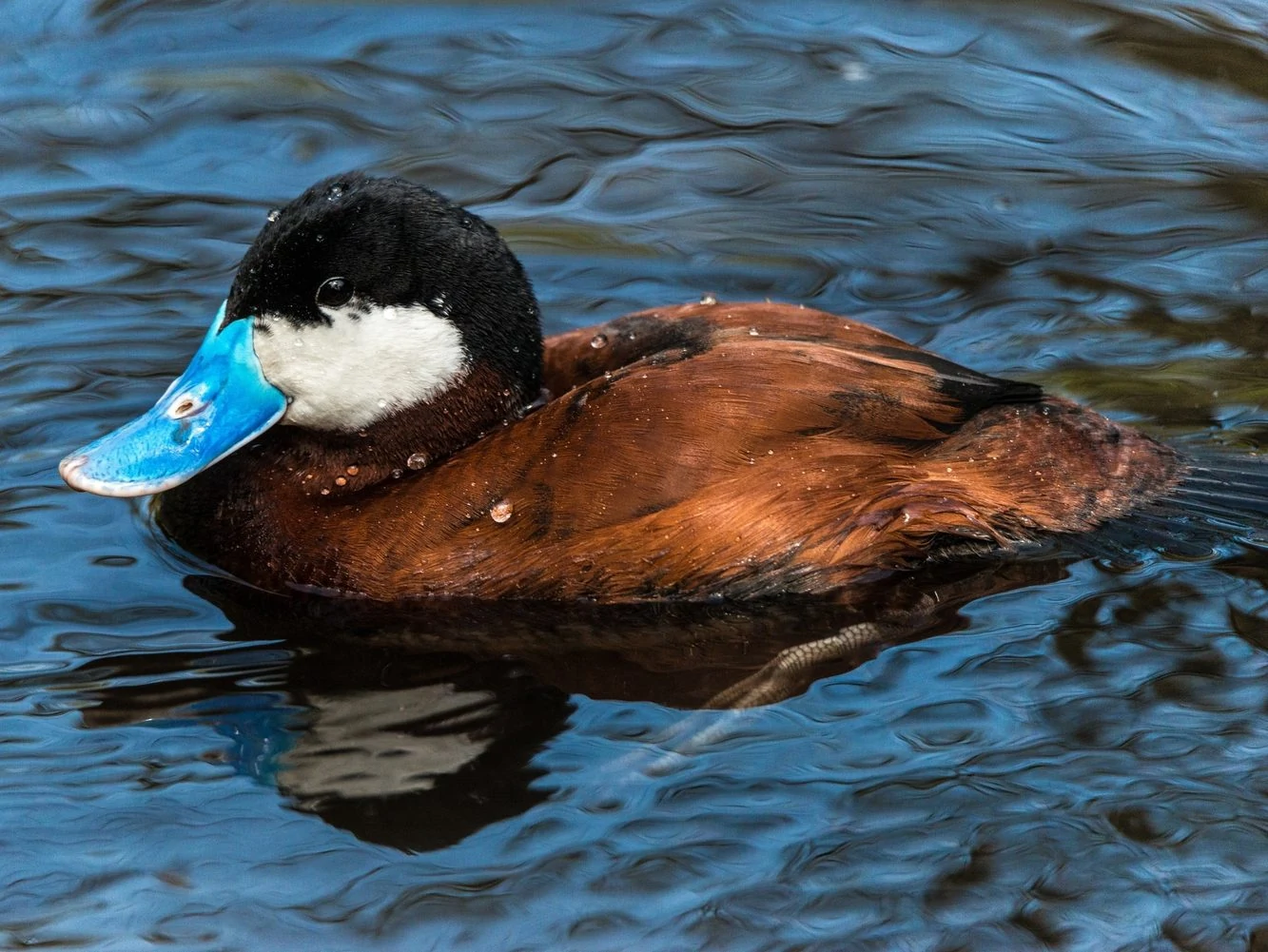
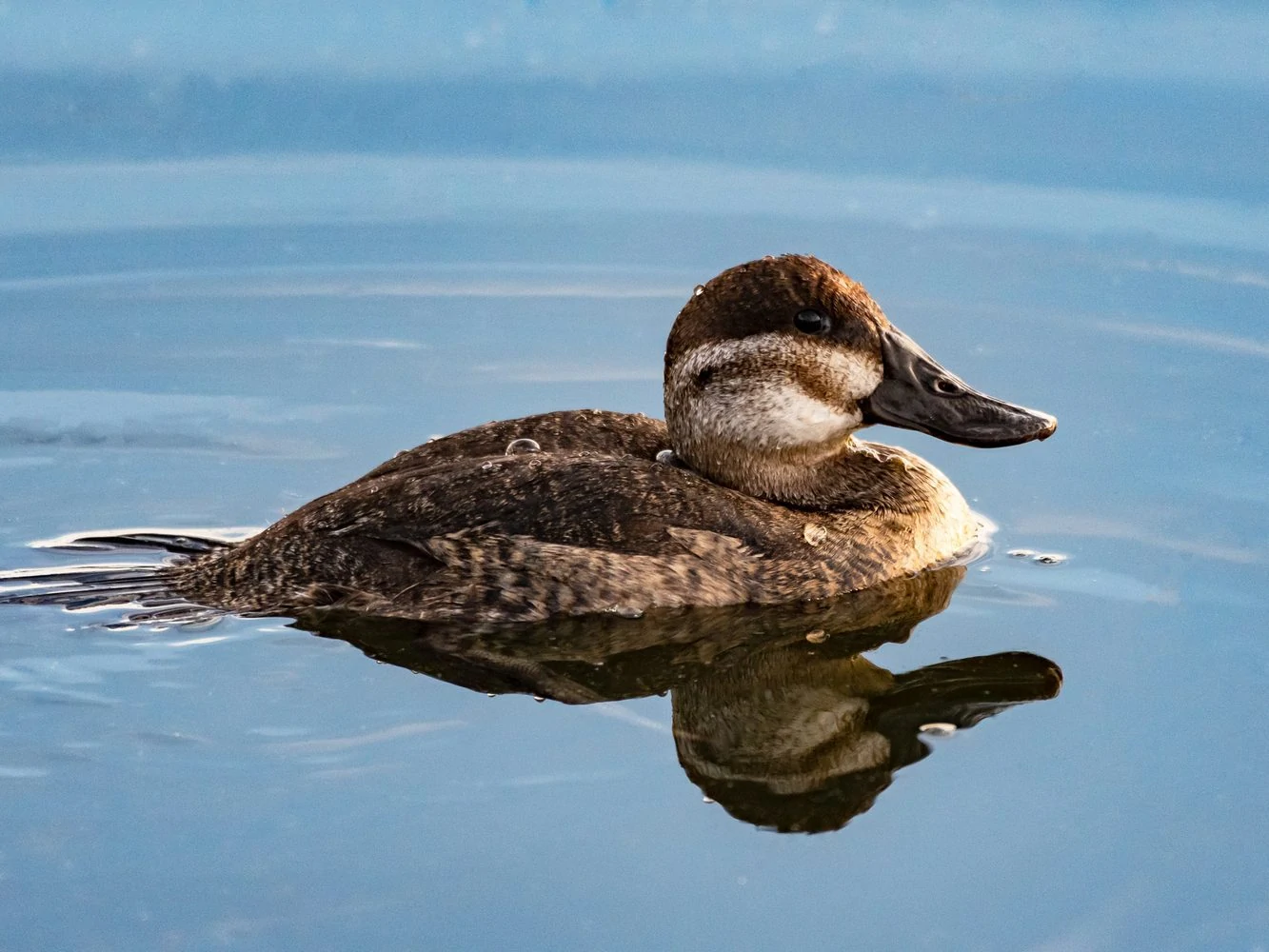
Ruddy Ducks are usually spotted in Iowa during migration, from March to May and from October to November, but a few hang around all year. They occur in up to 12% of checklists during fall.
Male Ruddy Ducks certainly live up to their name. During the breeding season, Male Ruddy Ducks are bright reddish-brown compared to their dull, grayish coloring when non-breeding. They have black caps on their heads that extend down the back of their necks, large white cheek patches, and bright blue bills.
Females have dark brown caps and similar but grayish cheek patches. They also have a slightly faint brown, horizontal line across their cheeks. Their bodies are also grayish-brown like the non-breeding males.
However, non-breeding males have the same distinct pattern and coloring as breeding males with respect to their heads.
- Oxyura jamaicensis
- Length: 14 – 16 in (35.56 – 40.64 cm)
- Weight: 28.04 oz (795 g)
- Wingspan: 21 – 24 in (53 – 61 cm)
Ruddy Ducks breed in western US states and western Canada before migrating to southern US states and the east and west coasts of the US and also Mexico. Some birds remain all year in western Mexico.
You can find Ruddy Ducks in freshwater marshes, lakes, and ponds with marshy borders and portions of open water during the breeding season. In winter, Ruddy Ducks prefer shallow, saltwater coastal bays and estuaries. If there are any ice-free lakes and ponds, Ruddy Ducks will most likely stay there as well.
Ruddy Ducks are divers and spend their time diving and swimming underwater for food. They feed on aquatic vegetation, like the seeds and roots of aquatic plants, and may also eat aquatic insects, shellfish, and crustaceans. They also skim the water surface and strain mud and water through their bills to eat, so they may eat small fish and mollusks too.
Ruddy Duck Call: Ruddy Ducks are relatively quiet, but during courtship, the males make display calls, and some sound like water bubbles. Females make a series of nasal grunts to call her young.
Male Ruddy Duck
Female Ruddy Duck
Nests of Ruddy Ducks are built by females to float on the water but remain hidden in dense marsh vegetation. Nests are made of grasses and cattails and lined with down. The female then anchors the floating nests to vegetation on the water.
Females lay five to fifteen eggs, some of them in other females’ nests. She incubates these for around twenty-five days. After hatching, the young head into the water where they can swim and dive immediately. Females look after them, but they essentially feed themselves. They can fly after around fifty days.
Fun Fact: In Europe, Ruddy Ducks are included in the list of Invasive Alien Species of Union Concern since 2016. This means that the species cannot be imported, bred, transported, commercialized, or intentionally released into the environment in the whole of the European Union.
15. Redhead
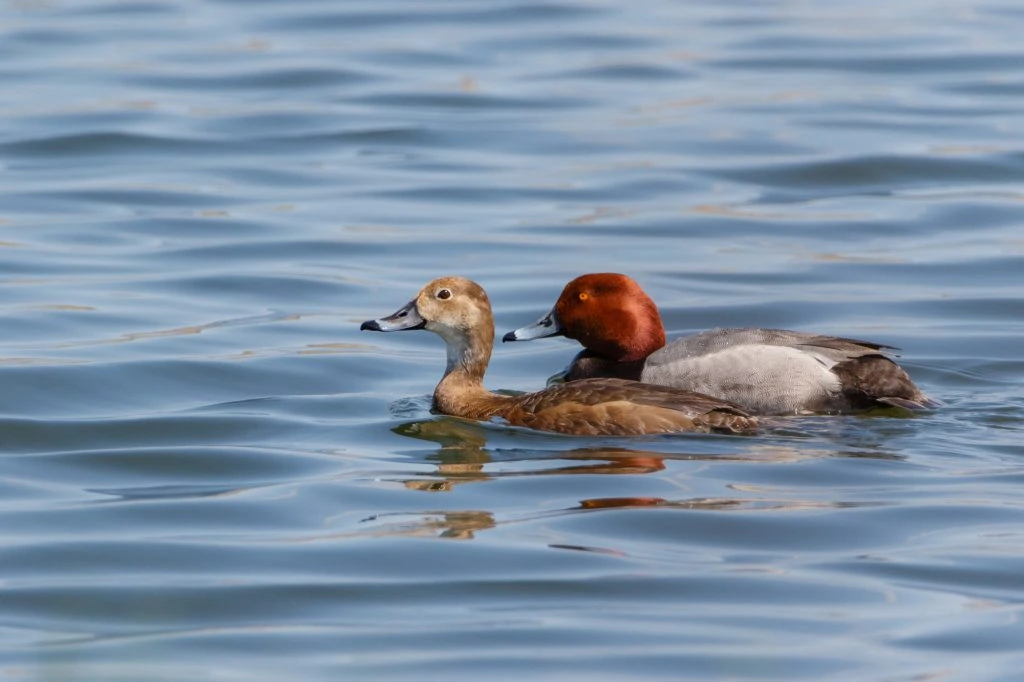
Redheads appear in 1% of winter checklists. They are usually spotted in Iowa from October to June, but a few stay all year.
Redheads are exactly what these medium-sized diving birds are. They have a striking red head, contrasting with a black throat and chest and a gray body. Their bill is blue-gray with a black tip. Females share the same bill but are otherwise brown all over.
- Aythya americana
- Length: 18 -22 in (46 – 56 cm)
- Weight: 43.03 oz (1219 g)
- Wingspan: 29 – 35 in (74 – 89 cm)
Redheads breed in western Canada, Alaska, and western US states before migrating for winter to southern US states, the east coast of the US, Mexico, and the Caribbean.
You can find Redheads in marshes, open lakes, reedy ponds, and bays where the water is deep enough to dive and root out plant vegetation. In winter, they migrate to coastal shorelines with calm waters or in reservoirs and estuaries.
Redheads dive for food, but they don’t go as deep as other ducks. Their movement may be more similar to dabbling. They eat a lot of plant vegetation when it’s not the breeding season. Their food includes seeds, tubers of pondweeds, water lilies, and grasses. Breeding season means they eat a lot of animals like mollusks, insects, and small fish.
Redhead Calls:
Male Redhead
Female Redhead
Nests of Redheads are formed by the females over or near the water. They are thick and bulky, made out of plant stems, cattails, and sedges. Redheads lay nine to fourteen eggs, but there are times when they lay their eggs in other ducks’ nests. Incubation of the eggs lasts for about a month.
Fun Fact: Redheads can form large flocks of thousands in two Gulf of Mexico bays during winter.
16. Canvasback
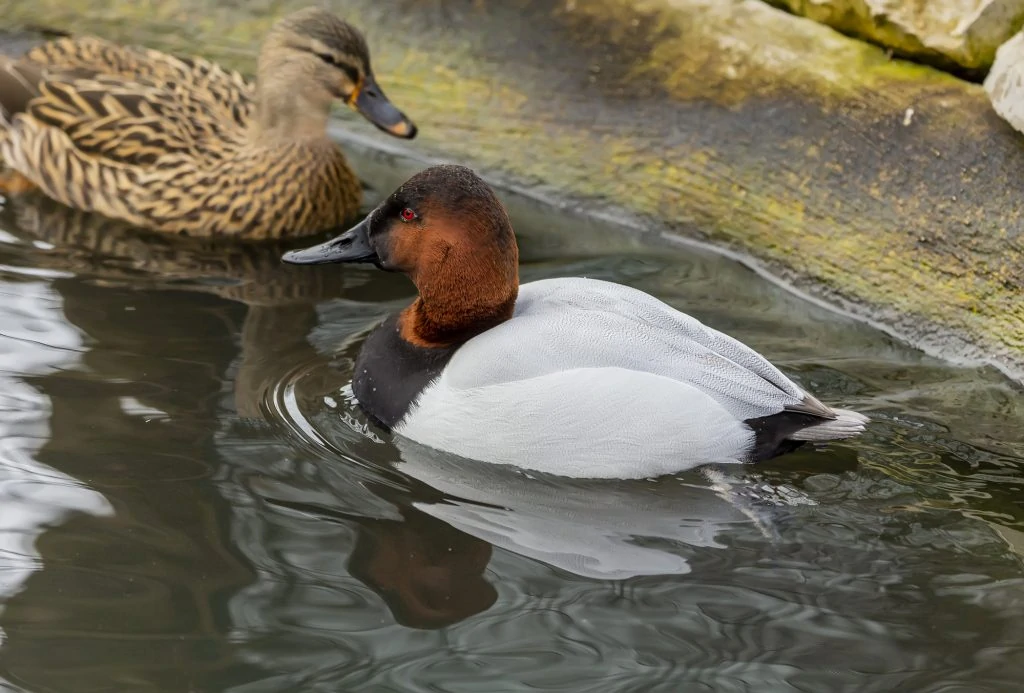
Canvasbacks spend winter in Iowa and occur in 2% of checklists at this time. They are mainly spotted from October to April, but a few remain here all year.
Male Canvasbacks are easily recognizable ducks from the Anatidae family because of their red eyes and sloping reddish-brown heads and throats. Their chest is black, but their bellies and backs are white or grayish. Their bottom is black too. Females are mostly brown in the head, throat, and chest, but their backs and bellies are brown and gray.
- Aythya valisineria
- Length: 19 – 24 in (48 – 61 cm)
- Weight: 58.48 oz (1657 g)
- Wingspan: 28 – 36 in (71 – 91 cm)
Canvasbacks breed in western Canada and some areas in northcentral states before migrating to southern US states, Mexico, and the east and west coasts of America.
You can find Canvasbacks in prairie marshes, deep-water marshes, lakes, bays, and ponds. They usually join large flocks with other birds, but their white bodies and sloping heads easily make them stand out. In winter, they prefer to live in freshwater lakes and coastal waters.
Canvasbacks are diving ducks, so they typically forage for food in open water. Their webbed feet are perfect for diving as they root out tubers and other plant food at the bottom of marshes, lakes, and ponds. They may occasionally dabble for seeds, buds, roots, snails, and insect larvae, too. Their favorite food is the tubers of Sago Pondweed.
Canvasback call:
Nests of the Canvasbacks are bulky and strong, made of reeds and grass that may be found on open water or on marshes with lots of plant vegetation and protective cover. The female lays five to twelve eggs that take about a month to hatch. It takes about sixty to seventy days for the ducklings to be able to fly and fend for themselves.
Fun Fact: The word “valisineria” in the Canvasbacks’ scientific name comes from Vallisneria americana, or wild celery, which is their favorite food during the non-breeding period.
17. Greater Scaup
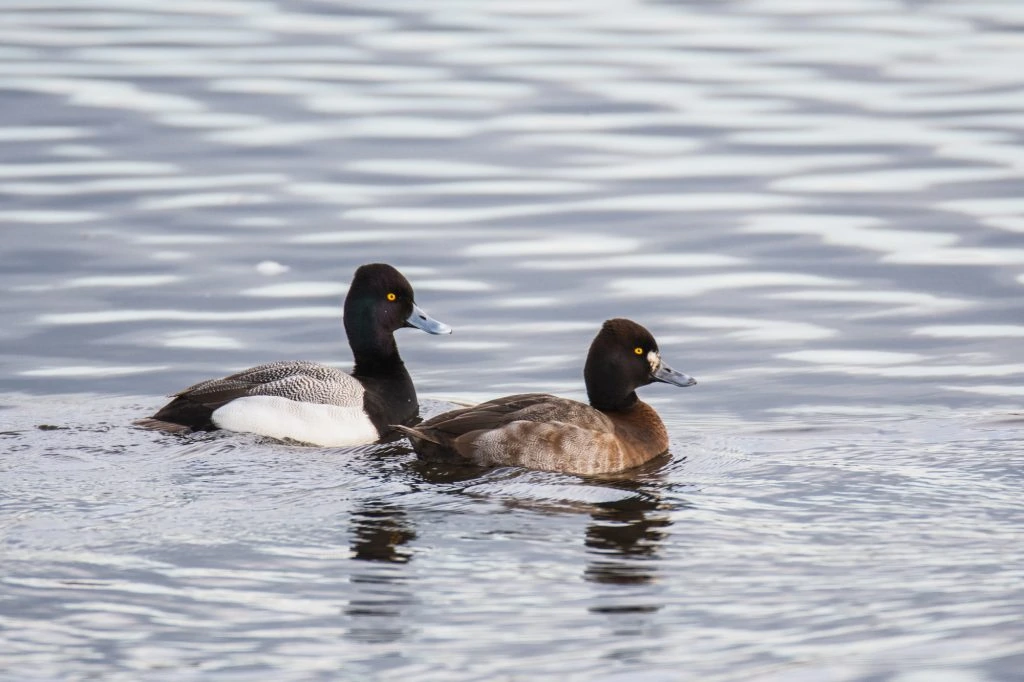
Greater Scaups are not very common in Iowa but they can be spotted during winter, from October to mid-June.
Greater Scaup males are ducks with iridescent dark green heads with blue bills, gray barred backs, and white sides. From a distance, they look black and white. Males molt after the breeding season and have mottled brown and gray bodies with darker heads.
Females are brown with a white patch between each eye and bill. Both males and females have yellow eyes. Greater Scaups look very similar to Lesser Scaup except with rounder heads.
- Aythya marila
- Length: 15.3 – 22.1 in (39 – 56 cm)
- Weight: 25.6 – 48.0 oz (726 – 1360 g)
- Wingspan: 28.4 – 31.1 in (72 – 79 cm)
Greater Scaups breed in the north of Canada and in Alaska before migrating to the Pacific and Atlantic Coasts for winter, but more on the Atlantic side.
You can find Greater Scaups in shallow lakes and ponds during the breeding season. In winter, they migrate towards the coast and can be found in bays and shores, but also on the Great Lakes. They form huge ‘rafts’ of birds out at sea.
Greater Scaups are diving ducks that eat invertebrates and plants at the bottom of lakes and the sea. They will push their open bills into the soft mud while swimming forward and quickly close it on any prey.
Greater Scaup call:
Greater Scaup flight call
Nests of Greater Scaups are on the ground, near water, and they add grass and down feathers to the small depression. They sometimes lay their eggs on floating mats of vegetation. They lay up to thirteen eggs which take around twenty-five days to hatch. The young leave the nest almost immediately.
Fun Fact: Greater Scaups can dive up to 23 feet underwater to hunt on the bottom for food.
Sea Ducks (Diving Ducks) (8 Species)
Sea ducks are members of the subfamily Mergini that are different from other diving ducks. They spend the majority of their time out at sea in winter and often breed in the far north.
18. Hooded Merganser
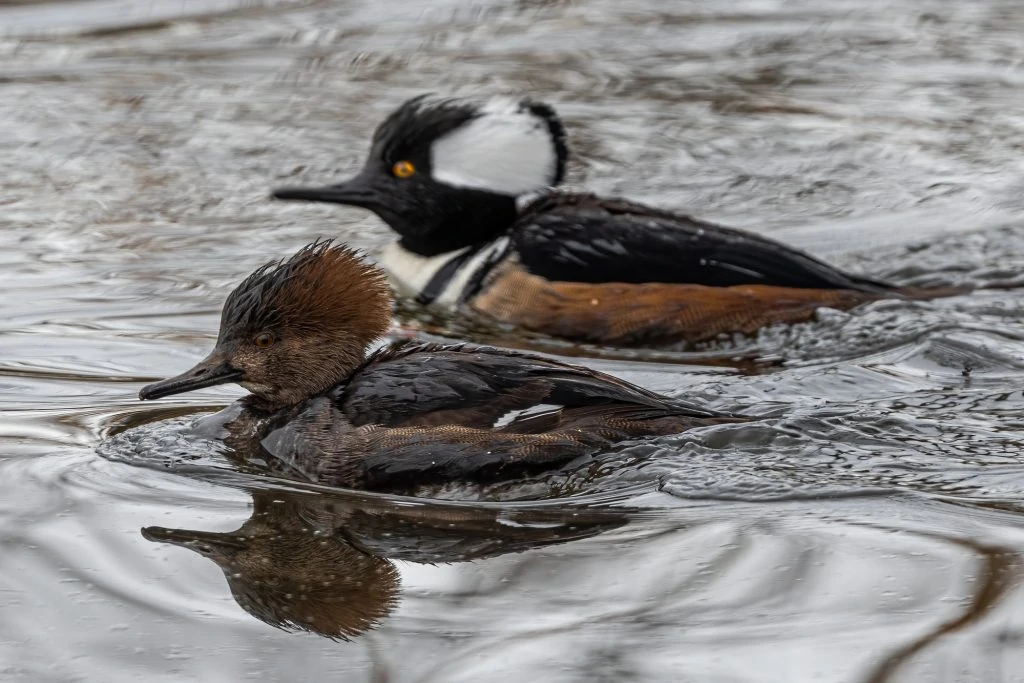
Hooded Mergansers are spotted in Iowa all year, but they are mainly seen during migration from March to April and from November to December. They appear in 2% of summer and winter checklists and in up to 15% of checklists during spring migration.
The Hooded Merganser is the second smallest species of Merganser and the only Merganser that lives entirely in North America.
Male Hooded Mergansers are striking ducks because of the crests on their head that they can raise or lower, which then changes the shape of their head and the pattern of the crest. When open, the crests are huge white patches, but when closed, they are a thick white line.
Apart from the white crests, their heads are black, and they have golden yellow eyes. Their bodies are black, except for their cinnamon-colored flanks and white chests. They have two black bars on their chests, and their lower backs have white stripes.
Females have the same crest, but theirs is reddish-brown. Their bodies are brownish-gray all over, lighter on the bottom and darker on top. Their eyes are somewhat duller than the males. Juveniles have brownish crests, black top half, and brownish-gray on their bottom half.
- Lophodytes cucullatus
- Length: 16 – 19 in (41 – 48 cm)
- Weight: 32.09 oz (909 g)
- Wingspan: 24 – 26 in (61 – 66 cm)
Hooded Mergansers live in eastern US states all year, but those in eastern Canada migrate for winter. They also spend all year in southwestern Canada. They can be spotted during migration in the Midwest and in winter in southern US states and the West Coast.
You can find Hooded Mergansers in freshwater lakes, ponds, and slow-moving rivers. They prefer to breed in small, forested ponds and estuaries with lots of aquatic vegetation. During migration, they visit a wide range of habitats, like open water, coastal bays, and tidal creeks. In winter, they are found in brackish swamps, saltwater bays, and inlets.
Hooded Mergansers forage by diving underwater. They catch their prey with their serrated and hooked bill. They will eat aquatic insects, fish, and crustaceans, particularly crayfish. In forested regions, they may eat snails, frogs, aquatic plants, and seeds.
Hooded Merganser Call: They are usually silent, but male Hooded Mergansers will make a frog-like croak during courtship, and females make a flight call.
Male Hooded Merganser call
Female Hooded Merganser call
Nests of Hooded Mergansers are often found in tree cavities that are about ten to twenty feet above the ground. They are usually beside or close to a water source and lined only with down feathers. Females lay seven to fifteen eggs and will incubate them all at the same time after the last egg has been laid. The incubation period usually takes just over thirty days.
Within twenty-four hours after hatching, the young jump to the ground from the nest and head to the closest water source. They can swim on their own and can find their own food. The female will still tend to them and lead them to areas with abundant food but only for a few more weeks.
Fun Fact: Hooded Mergansers can see underwater, which helps them when they forage for food.
19. Common Goldeneye
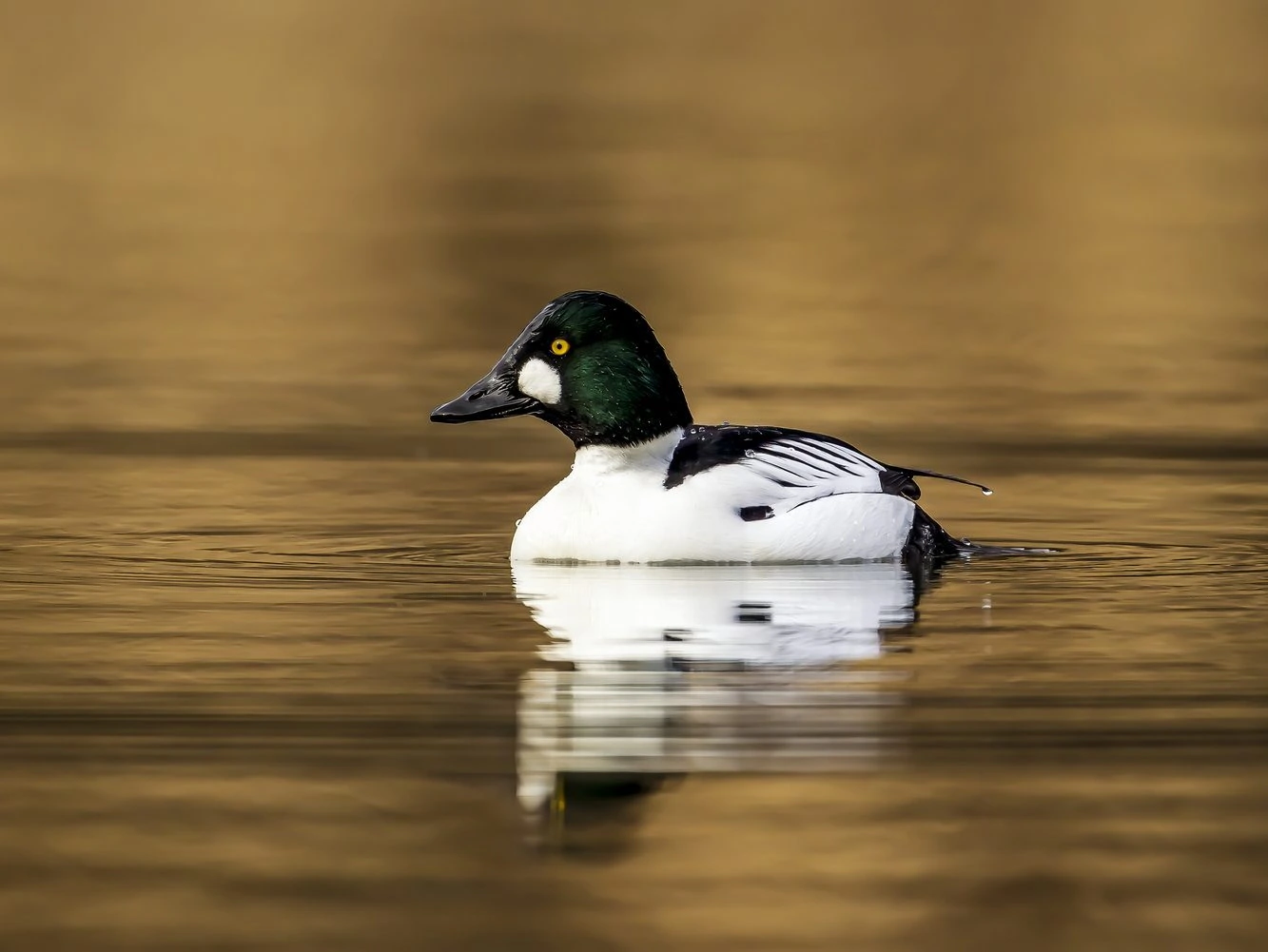
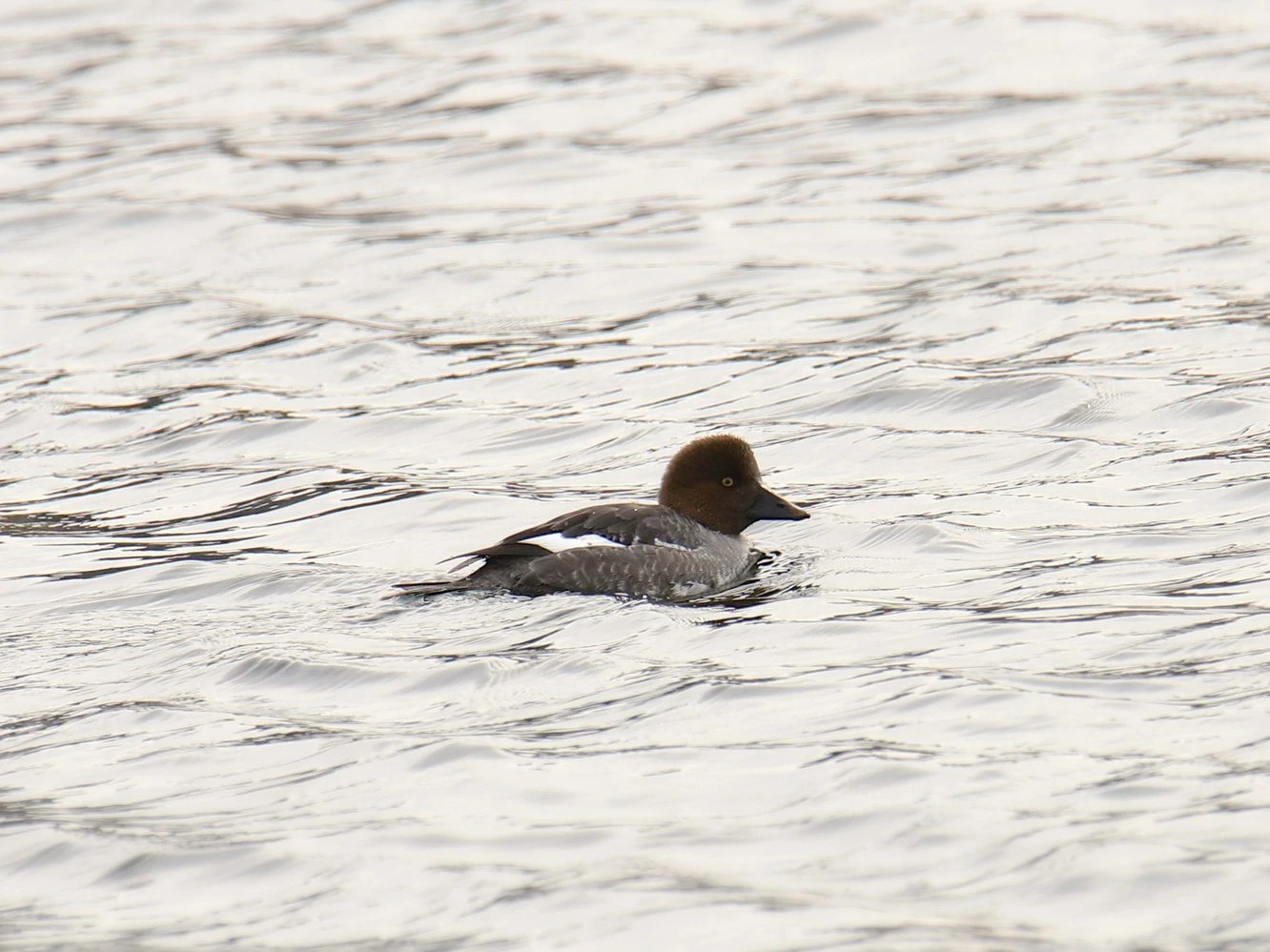
Common Goldeneyes are winter birds in Iowa and are mainly spotted from mid-October to May. They appear in 7% of checklists at this time.
Common Goldeneye males have iridescent green heads and can look almost black. They have a white spot under their yellow eyes. They have white bodies and sides and black backs.
Female Common Goldeneyes are grayish-brown with brown heads. Both males and females have black bills, but females have a yellow tip.
- Bucephala clangula
- Length: 15.8 – 20.1 in (40 – 51 cm)
- Weight: 21.2 – 45.9 oz (600 – 1300 g)
- Wingspan: 30.3 – 32.7 in (77 – 83 cm)
Common Goldeneyes breed in Canada and Alaska in summer and migrate late to the lower 48 for winter.
You can find Common Goldeneyes in boreal forest lakes during the breeding season and in coastal areas in winter. Common Goldeneyes are diving ducks that feed on crabs, shrimp, crayfish, fish, fish eggs, and insects.
Common Goldeneye Calls: They are quiet ducks, but male Common Goldeneyes make soft calls, and females make harsh alarm calls.
Common Goldeneye Male
Common Goldeneye Alarm call
Nests of Common Goldeneye are in holes in trees, and they use whatever is in there, plus some plucked-down feathers for the nesting material. They lay up to nine eggs which take around thirty days to hatch.
Fun Fact: Common Goldeneyes can fly at speeds of over 40 miles per hour.
20. Common Merganser
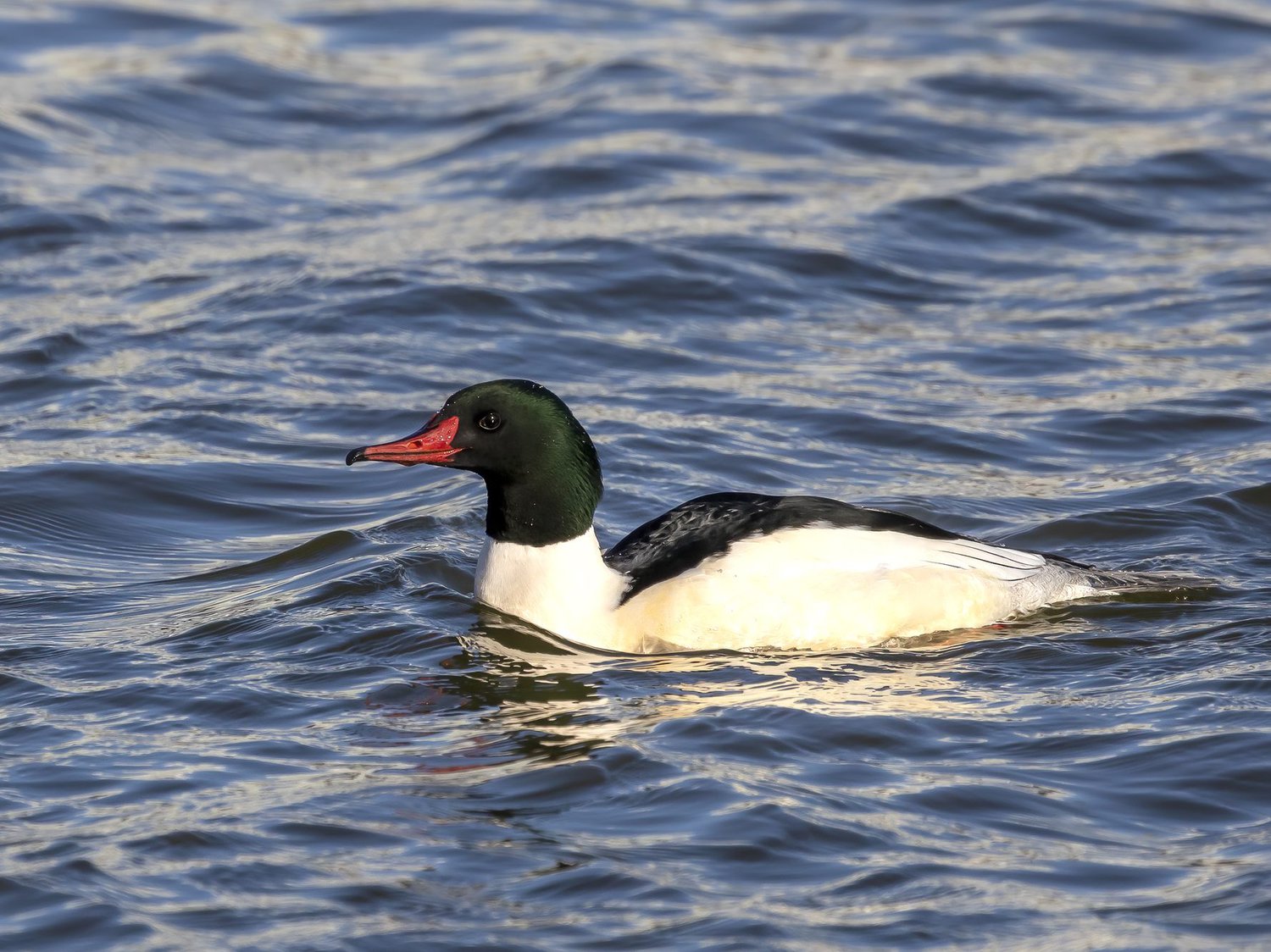

Common Mergansers are usually spotted in Iowa from November to April. They are recorded in 5% of winter checklists.
Male Common Mergansers are simple-patterned birds but striking nonetheless. They have black heads with a glossy green sheen, dark eyes, bright-red, long, serrated bills, white bodies, and black backs. While they do have a crest, it’s not often visible.
Females have a more prominent reddish-brown crest. They have the same red, serrated bill as the males. They also have a white chin patch, and their breast and bellies are white, their backs are gray. Juveniles resemble females.
- Mergus merganser
- Length: 22 – 27 in (56 – 69 cm)
- Weight: 60.8 oz (1723 g)
- Wingspan: 31 – 37 in (79 – 94 cm)
Common Mergansers breed in Canada and migrate to the US. Some remain all year in northeastern and northwestern US states.
You can find Common Mergansers in freshwater lakes and ponds. They are also found in small rivers and shallow shorelines and even sitting on rocks in the middle of a stream. While they prefer freshwater habitats, they sometimes visit saltwater regions too, like coastal estuaries and harbors.
Common Mergansers are diving ducks, and they love to eat fish, particularly the adults. Their serrated bills make it easy for them to capture and hold these fish as well as mussels, crustaceans, and other aquatic creatures. Gulls often follow them when hunting to steal the fish from them.
Common Merganser Calls: They are usually fairly quiet, but Male Common Mergansers give alarm calls, and females make a series of grunting calls to their young.
Male Common Merganser call
Female Common Merganser call
Nests of Common Mergansers are usually found in a tree cavity in mature forests. They often use abandoned tree holes and line them with down feathers. They also use nest boxes where available. If there are no tree cavities, they use crevices on cliffsides.
Females lay six to seventeen eggs and have been known to lay eggs in other nests of the same species. They incubate these eggs for around thirty days. When the young hatch, they immediately head for the water to feed themselves. The female may assist them in finding food, but otherwise, they fend for themselves.
Fun Fact: Common Mergansers are also called “sawbills,” “fish ducks,” or “goosanders.”
21. Red-breasted Merganser
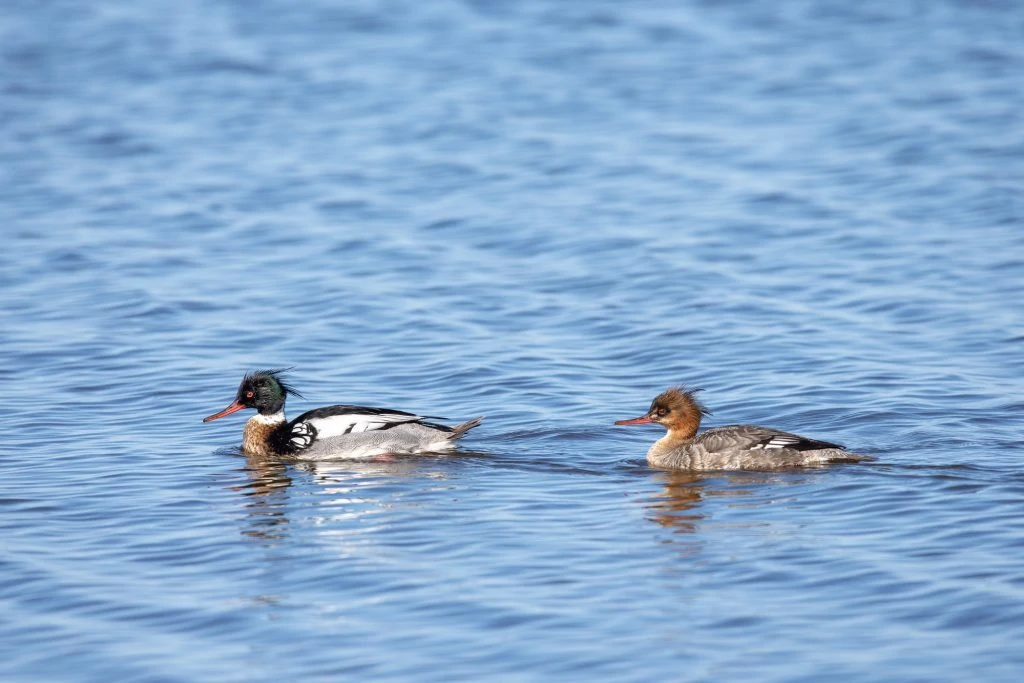
Red-breasted Mergansers migrate across Iowa and appear in up to 7% of checklists at this time. However, a few stay during winter.
Breeding Male Red-breasted Mergansers are certainly noticeable ducks. Their black, glossy green, ragged, and spiky crests, dark red eyes, and long, serrated orange bills certainly make them stand out among other ducks. They also have a white neck collar, mottled reddish-brown breast, black and white back, and gray flanks.
Females and non-breeding males have reddish-brown spiky crests, red eyes, long, red bills, white throats, and gray bodies.
- Mergus serrator
- Length: 16 – 26 in (41 – 66 cm)
- Weight: 47.61 oz (1349 g)
- Wingspan: 31 – 35 in (79 – 89 cm)
Red-breasted Mergansers breed in Canada, except in the southwest, before migrating to the coasts of the US and Canada. They can be spotted during migration in southwestern Canada and all US states.
You can find Red-breasted Mergansers in tundra ponds, freshwater lakes and rivers, and brackish and saltwater wetlands, usually near the coast during the breeding season. In winter, they may also be found in the ocean.
Red-breasted mergansers normally dive when foraging for food and will pursue their prey underwater until they catch them. They will occasionally cooperate with other groups and herd schools of fish into shallow waters to make them easier to catch. Aside from fish, they also eat crustaceans, insects, and amphibians.
Red-breasted Merganser call: They are quiet birds, but they make calls during courtship or when alarmed.
Male Red-breasted Merganser
Female Red-breasted Merganser
Nests of Red-breasted Mergansers are often found on the ground, in a shallow depression, near the water. Females usually line them with plants and down feathers. Females lay five to sixteen eggs but may lay them in other females’ nests. The incubation period may run from twenty-nine to thirty-five days and is mostly done by the female.
Fun Fact: Red-breasted Mergansers don’t acquire their breeding feathers until they are two years old.
22. Long-tailed Duck
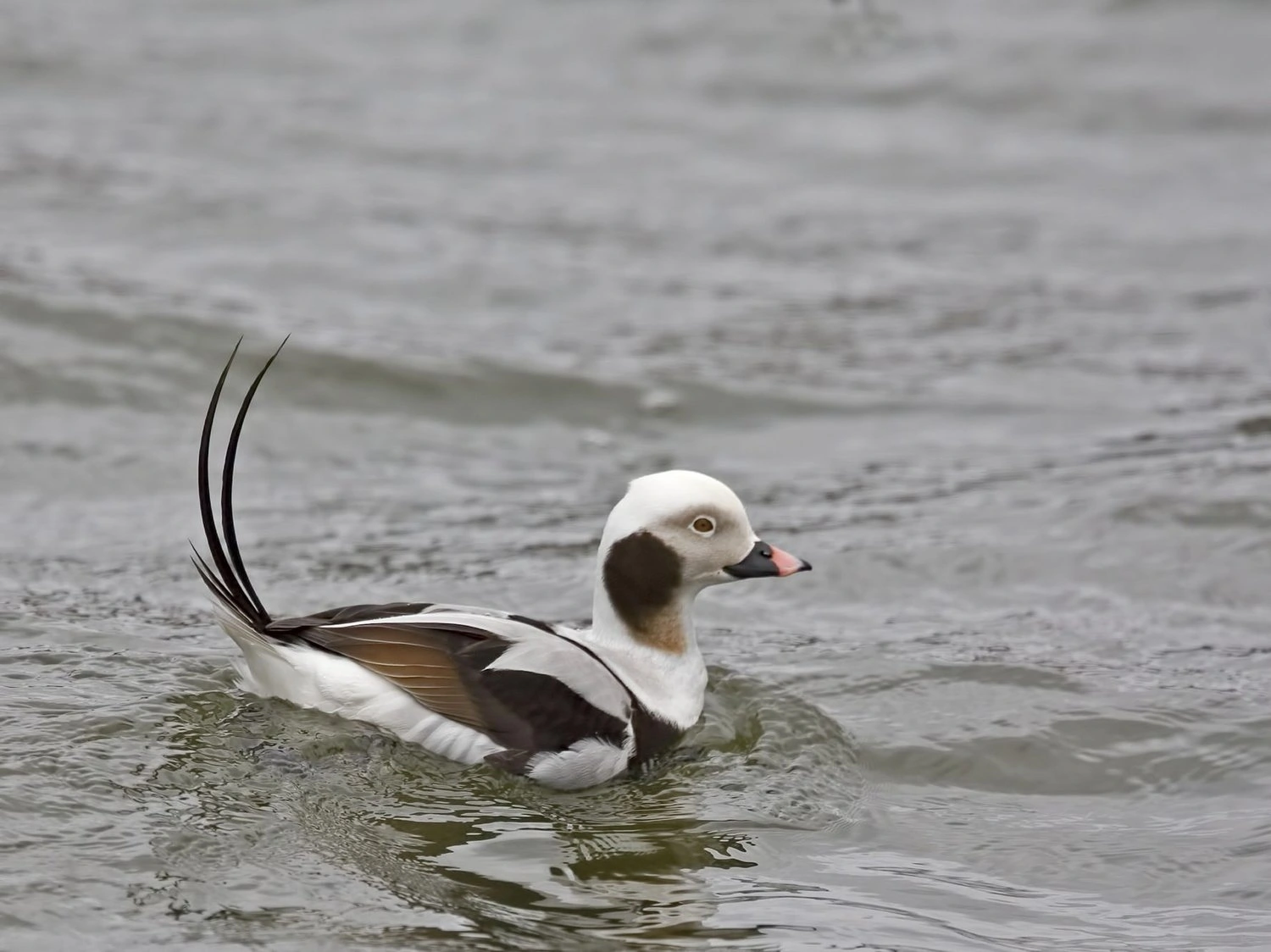
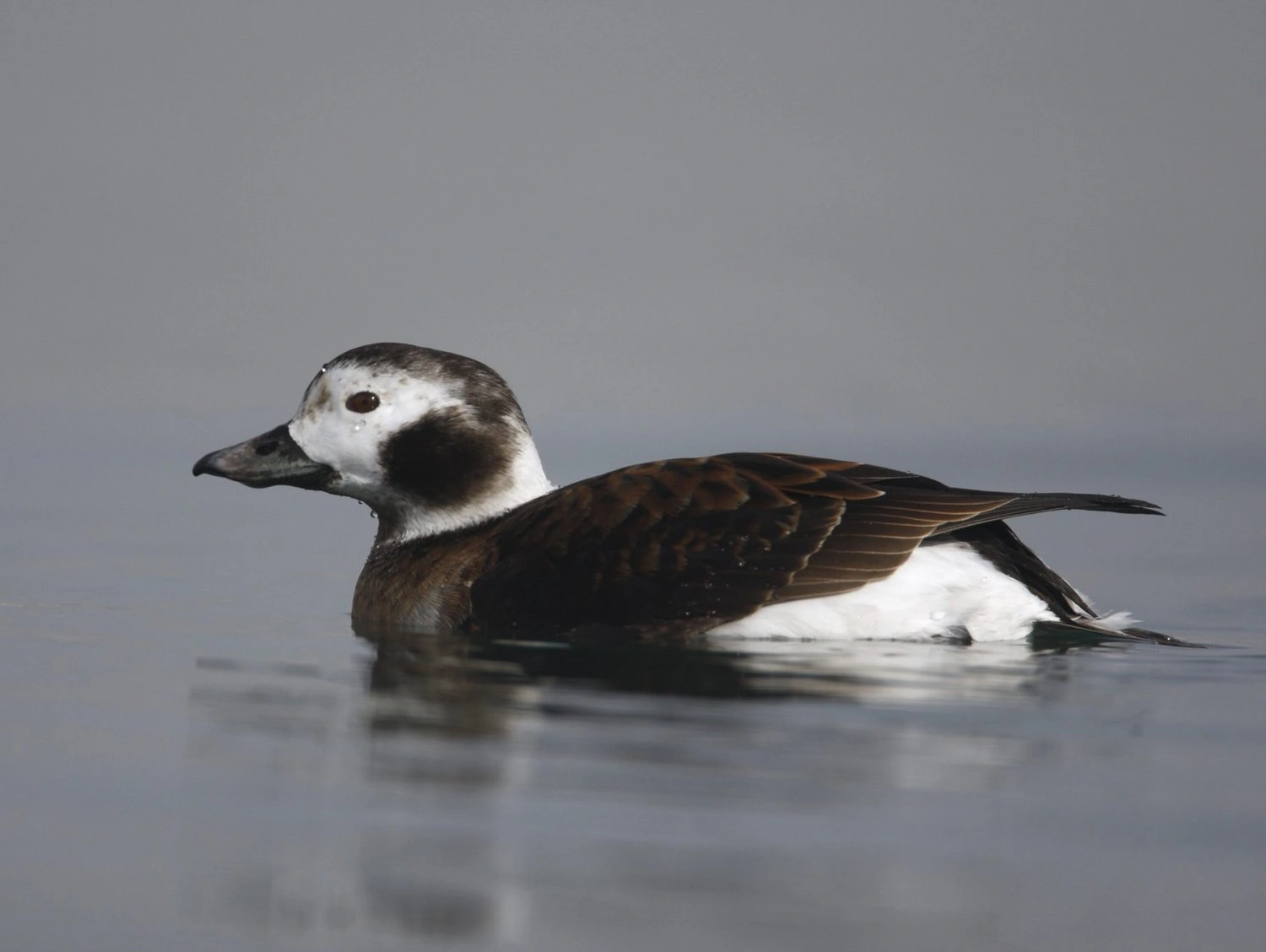
Long-tailed Ducks are vulnerable species in Iowa and are usually spotted during winter, from November to mid-May.
The Long-tailed Duck is a small diving duck that has rather obvious slender, long and black tail feathers, hence the name. What’s interesting about the Long-Tailed Duck is that its coloring reverses between breeding (summer) and non-breeding (winter) seasons.
Adult non-breeding males have white crowns, foreheads, necks, backs, sides, and bellies. They have a gray mask and a dark cheek patch, a pink band across their black bill, and black breasts and wings with white shoulder blades. Their tails are long and black.
Their coloring reverses during the breeding season or in summer. Everything that was white is now dark-colored. Their crown, foreheads, necks, backs, sides, and bellies are now dark. Their cheek patch is now white, and the band on their dark bill is now gray.
Adult non-breeding females have dark crowns, white heads with a dark patch on the cheek, and gray bills. They have white necks and bellies. They have brown throats, backs, wings, and a relatively shorter tail. Like the males, their coloring reverses during the breeding season. They become browner overall but with a white patch around the eye and neck.
Juveniles resemble adult non-breeding females, particularly in coloring and with a shorter tail. But they have a darker patch on the cheek and a yellow-orange band on the gray bill like the adult males.
- Clangula hyemalis
- Length: 15 – 22 in (38 – 56 cm)
- Weight: 31.74 oz (900 g)
- Wingspan: 26 – 31 in (66 – 79 cm)
Long-tailed Ducks breed in the far north of Canada and Alaska and across northern Europe and northern Asia. In winter, they migrate south to the US, and those in Europe and Asia move south in these regions.
You can find Long-Tailed Ducks in many coastal water habitats. They are often in bays, harbors, fjords, estuaries, straits, and mudflats. During the breeding season, you can find them along ocean coasts and large freshwater lakes. They are known to join large flocks in areas with extensive sea ice.
Long-tailed Ducks usually dive for mollusks, crustaceans, and small fish in the oceans during winter. They are known to dive as deep as 200 feet to reach zooplankton that is usually at the bottom of water columns. They use their wings to propel them through the water. On tundra, during summer, they mostly eat insects, fish eggs, and plants.
Long-tailed Duck calls:
Male Long-tailed Duck
Female Long-tailed Duck
Nests of Long-tailed Ducks are usually shallow depressions on the ground made by females. They are grouped in small, tight clusters with other females’ nests. The first egg is covered with a layer of grasses, and with the addition of a second egg, the females add their own down to the nest.
Females can lay anywhere from six to nine eggs. They alone incubate the eggs for up to twenty-nine days. Males leave for their post-breeding molting site. The young can feed when they hatch.
Fun Fact: The Long-tailed Duck used to be known as “oldsquaw.”
23. White-winged Scoter
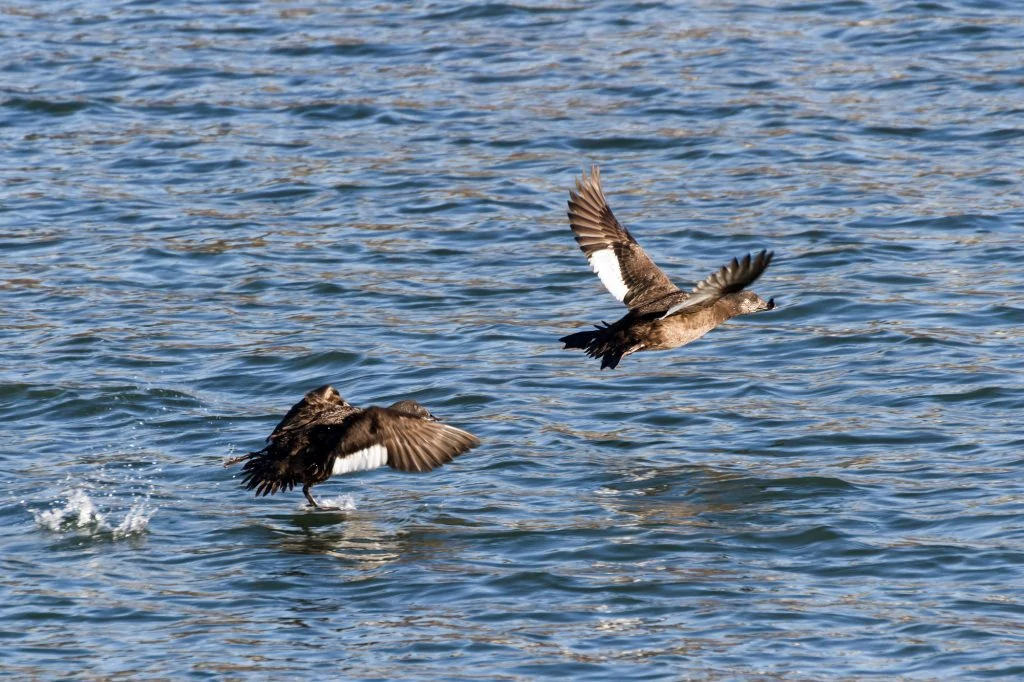
White-winged Scoters are not very common in Iowa, but they are winter birds and are spotted from October to April.
White-winged Scoters are the largest of the North American Scoters. They’re easily distinguishable from the other three because of their white wing patch since the other two Scoters have totally black wings.
Male White-winged Scoters also have the distinct white, reverse comma marking around the eye, earning them the nickname “Viking Horn.” Their orange-tipped bill is short and less bulbous than other Scoters, but it does have a large, dark knob at its base. Their bodies are mostly black.
Female and Juvenile White-winged Scoters are similar. They are both dark brown with white patches in front and behind their eyes. They have dark gray bills with a smaller knob at the base.
- Melanitta deglandi
- Length: 19 – 24 in (48 – 61 cm)
- Weight: 62.4 oz (1768 g)
- Wingspan: 33 – 41 in (84 – 104 cm)
White-winged Scoters breed in western Canada and Alaska before migrating for winter to the US and Canadian coasts.
You can find White-winged Scoters in northern forests near freshwater lakes and wetlands during their breeding season. During the winter, they prefer the open ocean and coastal environments, particularly bays and inlets.
White-winged Scoters are experts in diving deep underwater, capable of holding their breath while wrestling with shellfish from underwater rocks.
They usually forage in large flocks and prefer to forage from the bottom, but they will also take prey from the water’s surface. In freshwater habitats, they feed on mollusks, crustaceans, small fish, and aquatic insects.
White-winged Scoter call:
Nests of White-winged Scoters are shallow depressions on the ground, mostly concealed under a thick bush or a crevice and close to the water. They are built with plant material and lined with down.
The female lays eight to ten eggs and incubates them for twenty-five days to a month. The young leave the nest after hatching and can already feed themselves. The female takes care of them for about three more weeks.
Fun Fact: Female White-winged Scoters return to the nesting area where they were hatched. This behavior is called “Natal Philopatry.”
24. Surf Scoter
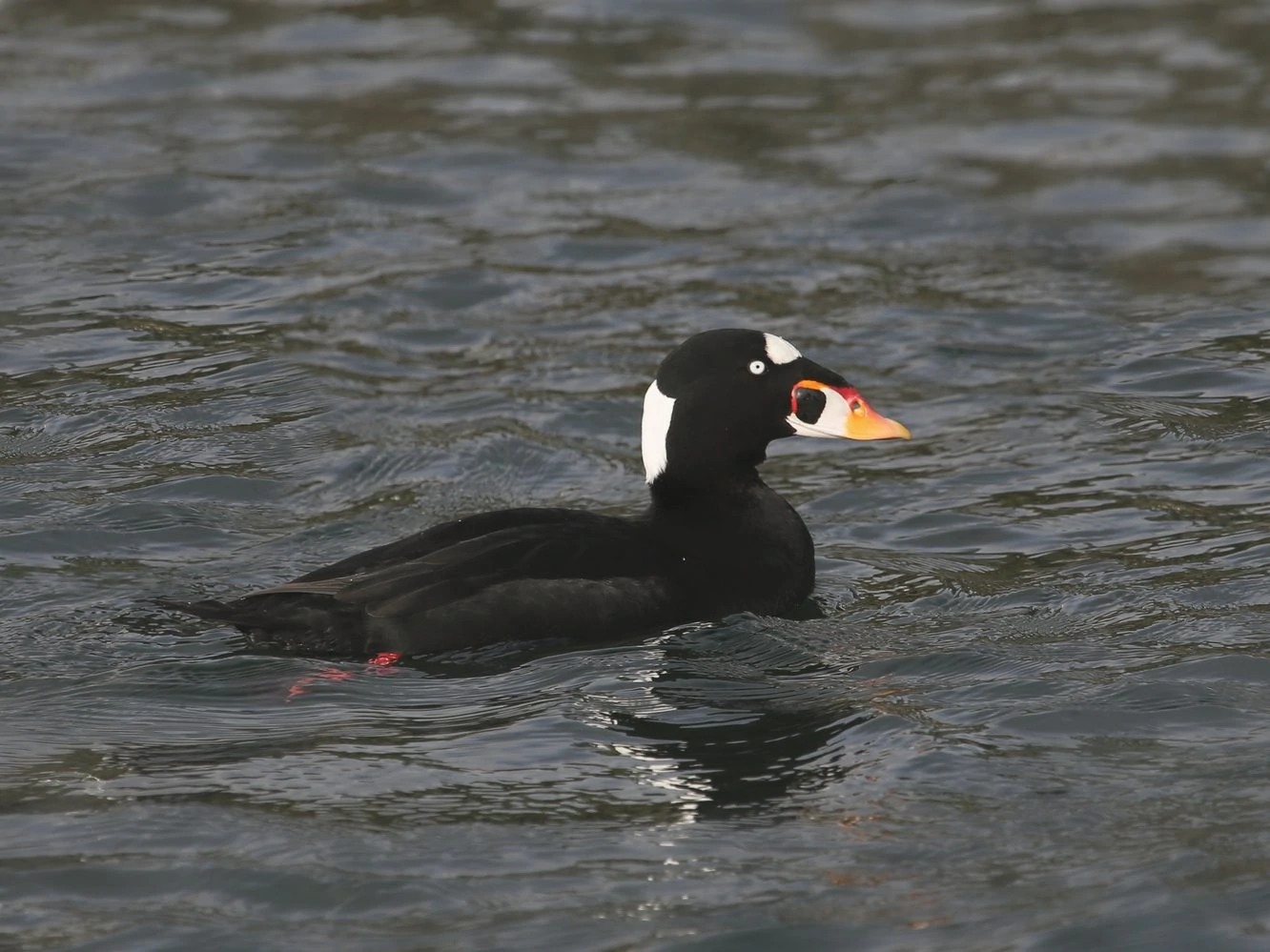
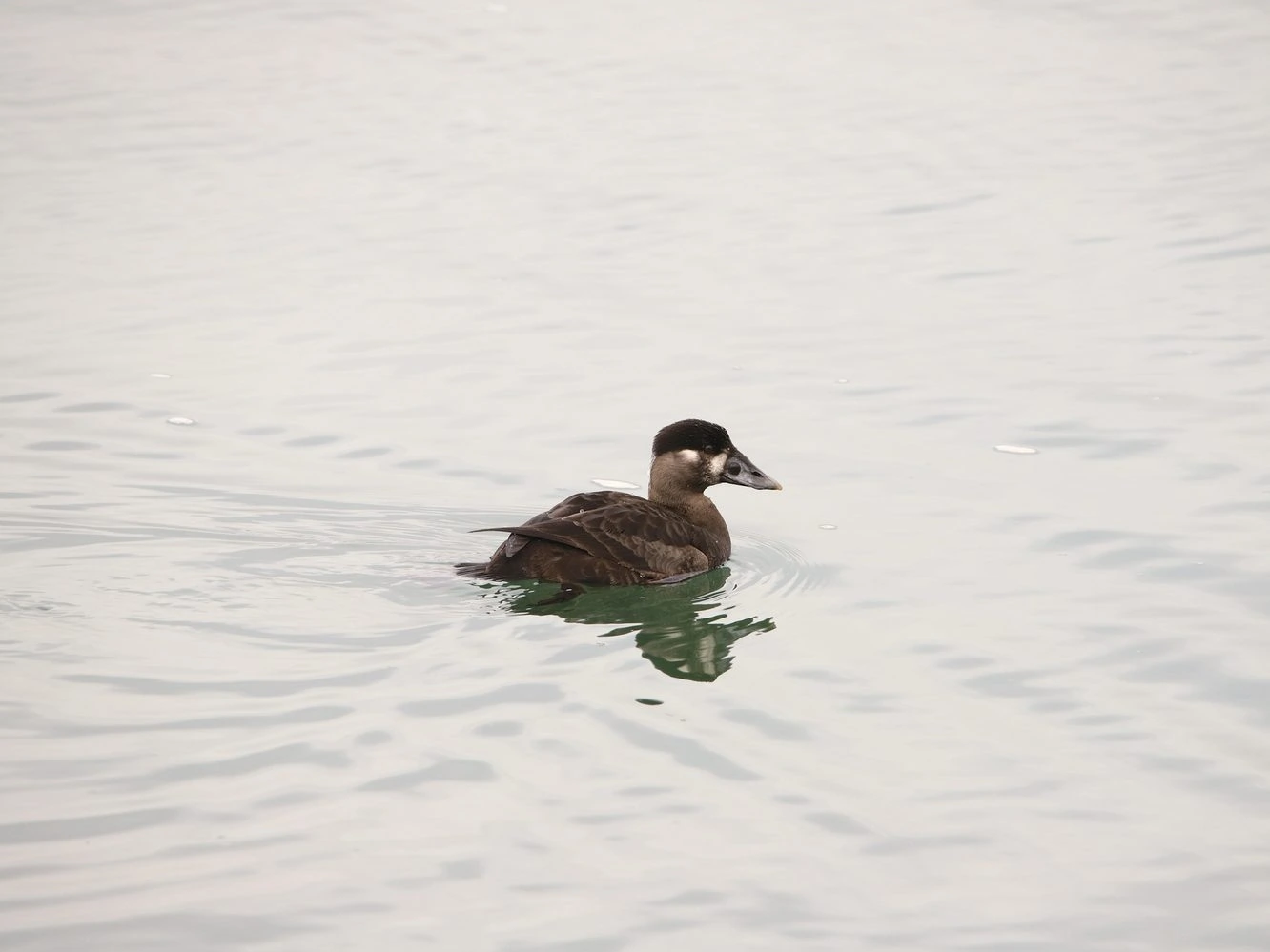
Surf Scoters are usually spotted in Iowa during migration, but they are not very common.
Male Surf Scoters are medium-sized birds that are sometimes called “old skunk-head coot” because of the distinct white patches on their forehead and nape that stand out against their black, velvety feathers.
Aside from these distinctive features, male surf scoters also have a large orange bill with white, red, and yellow patterns. At the base of the bill is a large, black spot. Their eyes are white.
Female Surf Scoters are mostly dark gray, but they have the white patch at the base of their bill and near the back of their eyes. They have the same bill as the male, except that theirs is smaller and dark gray.
Juveniles are brownish, have black eyes, and have the same coloring and shape of the bill as the males.
- Melanitta perspicillata
- Length: 17 – 21 in (43 – 53 cm)
- Weight: 35.27 oz (1000 g)
- Wingspan: 30 – 36 in (76 – 91 cm)
Surf Scoters breed in northern Canada and Alaska before migrating to the US coasts and Canadian coast.
You can find Surf Scoters in forests near freshwater lakes during the breeding season. During their molting season, they prefer shallow bays, inlets, and estuaries, places that have a good source of food and lesser threats of predation. But, they are most likely on the ocean during winter.
Surf Scoters mostly get their food by diving underwater. They also adapt their foraging attempts depending on the abundance of food. For instance, they will feed on Pacific Herring eggs during their spawning since there is less effort but more food supply. During the breeding period, they will find freshwater invertebrates and crustaceans.
Surf Scoter calls:
Nests of Surf Scoters are usually well-concealed, built on the ground, under thick brush or low tree branches, and not always near water. The female digs a bowl-shaped depression on the ground and lines it with grass and down feathers then lays around five to eight eggs which she incubates for about a month. In dense breeding areas, broods may get mixed up.
Fun Fact: Gulls often try to steal the prey that Surf Scoters catch from diving. That’s why flocks frequently make synchronized dives and surfacing to make it difficult for other birds to steal from them.
25. Black Scoter
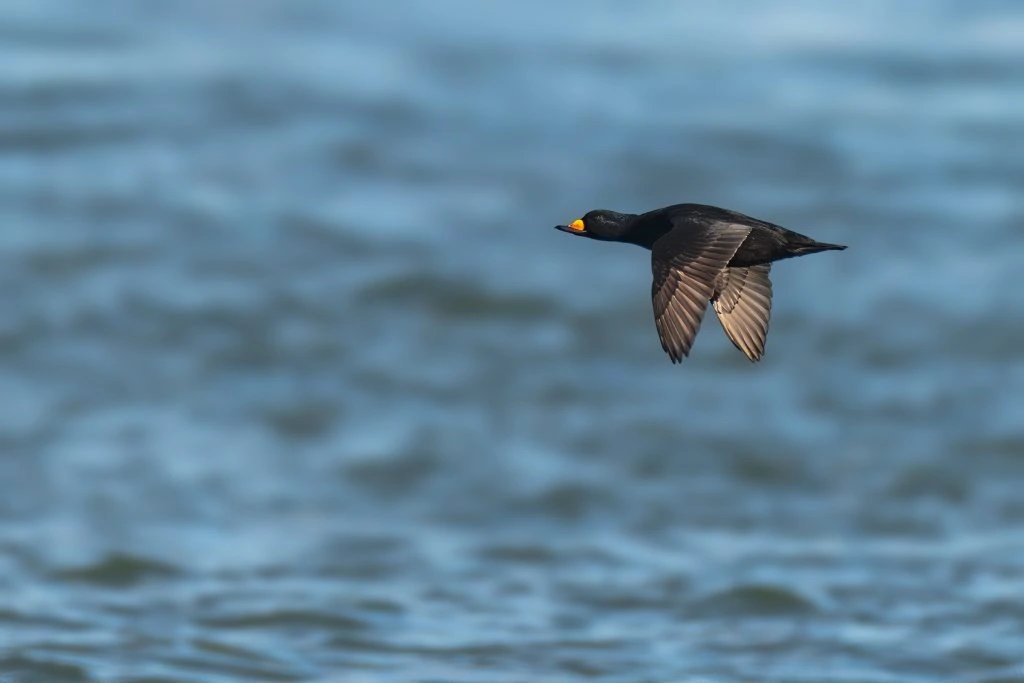
Black Scoters are near-threatened species in Iowa and although they are not often seen here, you might spot some during migration.
The Black Scoter is also called American Scoter. Male Black Scoters are aptly named because their whole bodies are velvety black, except for a bright yellow patch at the base of their bills.
Female Black Scoters aren’t black at all. They are brownish overall, with the lower half of their head paler than the rest of the body. Their cap is dark brown, and their bill is black.
Juveniles are a combination of both males and females. Their coloring and dark cap are like the females, but they also have the yellow knob at the base of their bill like the males.
- Melanitta americana
- Length: 17 – 21 in (43 – 53 cm)
- Weight: 387.4 oz (1088 g)
- Wingspan: 30 – 35 in (76 – 89 cm)
Black Scoters breed in Canada and Alaska before migrating to coastal areas of the United States.
You can find Black Scoters primarily in saltwater, particularly along rocky coastlines, during winter, or when migrating. They usually form large winter flocks with other scoter species. During the nesting period, they move to more sheltered habitats like ponds and small lakes with vegetation on the edges.
Black Scoters dive for shellfish and mollusks in oceans and bay coasts. They may occasionally eat crabs and shrimp, and other marine vegetation on top of shellfish and mollusks. When they’re in freshwater, they eat a lot of insects and their larvae, fish eggs, and other vegetation.
Black Scoter calls: They are noisy birds that are easily identified in winter with the males’ descending whistle.
Nests of Black Scoters are usually hidden in a rock crevice or on the ground sheltered by grass clumps. They are usually within a hundred feet of the water. The female makes a depression on the ground or on grass and lines it with her own feathers.
She will lay around eight to nine eggs and incubates them for about twenty-eight days. She will tend to them for about three weeks, after which they have to fend for themselves.
Fun Fact: Tens of thousands of Black Scoters migrate south together, creating a fantastic spectacle.
How To Identify Ducks
There are a few identifying features to help you identify ducks more quickly as they are often at a distance or in flight.
Beak shape
Some ducks have distinctive beaks, such as shovelers, canvasbacks, and mergansers. So get to know these ducks first to narrow down or discount the species.
White Patches
Ducks are often only seen from a distance and may be mixed with other species, and the lighting conditions may not be great. So how do you learn to recognize one of these many species?
The best way to identify ducks, especially when they are at a distance, is to get to know ‘where is the white.’ The white patches on ducks stand out and help you to identify which duck you have spotted more quickly.
Calls
Some ducks have distinctive calls and not just your general ‘quack’, so get to know some calls by listening to the calls in each of the summaries below.
Heads and Tails
Some ducks have crests or unusual head shapes, such as wood ducks or mergansers, so get to know these.
Not all ducks have short tails, some have long or curled tails, such as pintails, long-tailed ducks, and ruddy ducks.
Ducks By Season
Checklists for the state are a great resource to find out which birds are commonly spotted. These lists show which ducks are most commonly recorded on checklists for Iowa on ebird in summer and winter.
Ducks in Iowa in Summer:
Mallard 20.7%
Wood Duck 14.1%
Blue-winged Teal 10.1%
Northern Shoveler 3.7%
Hooded Merganser 2.2%
Gadwall 1.7%
Lesser Scaup 1.3%
Ruddy Duck 1.3%
Green-winged Teal 1.0%
Ring-necked Duck 0.8%
Redhead 0.6%
Bufflehead 0.4%
American Wigeon 0.3%
Northern Pintail 0.2%
Red-breasted Merganser 0.2%
Canvasback 0.2%
Common Merganser 0.1%
Greater Scaup <0.1%
Cinnamon Teal <0.1%
Surf Scoter <0.1%
Common Goldeneye <0.1%
Long-tailed Duck <0.1%
American Black Duck <0.1%
Ducks in Iowa in Winter:
Mallard 18.7%
Common Goldeneye 7.7%
Common Merganser 5.6%
Lesser Scaup 3.3%
Hooded Merganser 2.8%
Ring-necked Duck 2.5%
Canvasback 1.9%
Gadwall 1.9%
Northern Pintail 1.7%
Redhead 1.5%
Bufflehead 1.4%
Ruddy Duck 1.2%
Northern Shoveler 1.0%
American Black Duck 1.0%
Green-winged Teal 0.9%
American Wigeon 0.7%
Red-breasted Merganser 0.5%
Greater Scaup 0.5%
Wood Duck 0.4%
Long-tailed Duck 0.3%
White-winged Scoter 0.1%
Surf Scoter <0.1%
Black Scoter <0.1%
Cinnamon Teal <0.1%
Blue-winged Teal <0.1%

